Critical Notes on Text and Interpretation
by Rosalyn Tureck, edited by Xoán Elías Castiñeira Varela
Table of Contents
Editor's Praeambulum
Preface
I. Principal Sources and Editorial Principles
- List of Manuscript Sources
- Manuscripts
- Transmission from Manuscript to First Unedited Publications to First Performance Editions
- Variant Selections, Branch Publications, Performance Indications
II. Notes on Text: Fantasia
- Variants in Principal Manuscript Sources
- Clefs and Key Signature – Fantasia and Fugue
- Note-text. Variant Chart
- Embellishment
- Symbols in Mus. Ms. P651
- Variant Chart
- Added Notes, m. 5
- The Final Chord
- Performance Indications in Manuscript Sources
- General
- Stemming and Beaming
- Fingering and Hand Disposition
- Phrasing
- Dynamics. Mus. Ms. P577
- Arpeggio
- The Arpeggio Symbol. Mus. Ms. P651
- The Arpeggio Section. Mus. Mss. P551, P577
III. Notes on Text: Fugue. Variants in Principal Manuscript Sources
- Note-text
- Embellishment
- Symbols
- Written-out Embellishments
- Phrasing Slurs
IV. Comments on Performance
- Fantasia
- General – Harpsichord and Piano
- Dynamics – Fantasia and Fugue
- General
- Harpsichord – Registration – Fantasia and Fugue
- Piano – Fantasia and Fugue
- Recitative: mm. 61-62
- Coda
- Embellishment
- Realizations – mm. 20, 59, 74, 79
- Appoggiature – Recitative
- Piano Pedaling
- Touch on the Piano
- Fingering – Harpsichord and Piano
- Realization of Arpeggio
- The Arpeggio Section – mm. 27-49
- Sources
- Analysis of Form and Structure
- Realization on Harpsichord and Piano
- Other Arpeggio Application
- The Arpeggio Section – mm. 27-49
- The Fantasia Concept
- Form
- Performance Style
- Fugue
- Embellishment
- Realization of Symbols
- Long Trills
- Dynamics on the Piano
- Phrasing an Articulation
- The Fugue Concept
Editor's Praeambulum
The following Critical Notes stem, in essence, from the material written by Rosalyn Tureck for her Critical and Performance Edition of Bach´s Chromatic Fantasia and Fugue BWV 903. Due to a variety of reasons including the lack of a finished edited music score, it is not possible to reproduce here the contents of Dr. Tureck's edition in their entirety. Notwithstanding the absence of a final note-text, this material, presented here in the form of Critical Notes, should serve a twofold purpose: first, to provide students, teachers and performers with substantial and accessible background information about the unique textual intricacies of the work; second, to give an scholarly account of Dr. Tureck´s interpretation thereof⎯an ideal complement to her multiple performances, which have appeared on record mostly on the VAI label. On this label, there are the following versions of BWV 903 (available at the time of writing): a version from 1981 (VAI 1139); a studio recording from the mid-eighties (VAI 1041); three live performances: one recorded at the Teatro Colón, Buenos Aires, in 1992, a second one, recorded at the Teatro il Sistina, Rome, 1996 (both on the VAI DVD 4238), and a third one recorded in a St. Petersburg recital in 1995. Compared to one another and considered from a listener´s perspective, these distinguished performances do not differ in their essential performance approach. They present, however, a number of slight tempo variations and, more importantly in terms of performance praxis analysis, differences in embellishment and arpeggio realization. Careful listening of these performance nuances will surely illuminate in a practical manner many of the textual aspects treated below.
The details of the history and concept of Rosalyn Tureck´s editorial project, explained in more detail in the general introduction, should be taken into account when reading these Critical Notes. In particular, the reader should be aware that Dr. Tureck began working on her Critical and Performance Edition of the Chromatic Fantasia and Fugue in the late sixties (if not before), and subsequently expanded the scope of her research continuously over more than thirty years⎯as far as I am aware, until at least 1996. Forty years ago, the Chromatic Fantasia and Fugue had not yet received full critical attention and the score was available in editions that, albeit prepared by eminent scholars and performers, still contained questionable note-text variants and errors, on the one hand, and offered little critical help so as to solve the interpretive challenges posed by the work, on the other. By publishing an urtext edition of BWV 903, Dr. Tureck aimed to propagate a music score free of editorial errors and corruptions and also to offer relevant interpretive guidance for the modern performer on both harpsichord and piano.
As everybody tackling the study of this work quickly learns, the Chromatic Fantasia and Fugue presents a high number of editorial challenges due to the absence of an autograph and to the existence of a very high number of manuscript copies, from Bach's family and student circle and from elsewhere. Moreover, since its first printing, published more than fifty years after Bach's death by Hoffmeister and Co. in 1802, the work was published by a long succession of editors⎯“some famous, some not so famous, and some infamous as a result of their edition”, as Dr. Tureck states in posthumous material written for her book A History of Bach Performance [2]. For the modern performer, the highly convoluted editorial history of BWV 903 implies an equally complex interpretive challenge. By the second half of the twentieth century, an abundance of music scores heavily edited with additions and alterations that had little to do with Johann Sebastian had produced a very high degree of confusion and controversy⎯it was this confusion what Dr. Tureck attempted to alleviate with her twofold editorial project on the Chromatic Fantasia and Fugue, the edition and the book on the history of Bach performance.
One of the aspects that most neatly distinguishes Dr. Tureck´s editorial vision of the Chromatic Fantasia and Fugue from the view of the majority of modern Bach scholars is her disinclination to break up the history of the work into distinct stages of compositional development [3]. Most, if not all, modern editors agree that the work we usually perform today is the result of three different and evolving compositional layers: first, the early version BWV 903a (the Rust Variant); second, an intermediate version (corresponding to Mus. MS Bach P 803, in the hand of Johann Tobias Krebs); third, the principal version, very similar to the intermediate one (the version corresponding to Mus. MS Bach P 651, in the hand of Johann Friedrich Agricola, a student of Bach in Leipzig). Ulrich Leisinger, editor of the 1999 Wiener Urtext Edition, provides next to the main score a fourth version, the copy transmitted by Johann Nikolaus Forkel (Mus. MS Bach P 212), in spite of the fact that it “has been the subject of many controversies and most authors agree in assuming that the individual readings of this version are the result of unauthorized changes of the original.” (Leisinger, ‘Preface’, Chromatic Fantasia: IX) This version forms the basis of the 1819 Griepenkerl edition. Leisinger believes that, due to the fact that Forkel was given the work by Wilhelm Friedemann Bach, “it can therefore not be ruled out that J.S. Bach was himself responsible for this late version of the ‘Chromatic Fantasia and Fugue’ and left it for the exclusive use of his favorite son.” (Ibid.) By contrast, Uwe Wolf, editor of the Urtext of the Neue Ausgabe sämtlicher Werke, concludes that “Forkel's readings are either corrupt or conjectural and therefore cannot be regarded as authentic.” (Wolf, ‘Preface’, Chromatic Fantasy: V).
In regard to the different versions of the Fantasia, Uwe Wolf writes:
the early and intermediate versions of the Fantasy can be clearly distinguished from each other and from the main version and can be edited relatively easily due to the paucity of the sources. Things become quite a bit different, however, when we turn to the main version. Although the piece did not undergo any substantive changes, it has come down to us in several variants that reveal a progressive detachment from the readings of the two earlier versions. In all likelihood Bach altered the piece and elaborated its details time and time again, perhaps during lessons.
(Wolf, ‘Preface’, Chromatic Fantasy: V).
It will be useful to quote here Dr. Tureck's comment in regard to the version usually known as ‘intermediate’, which exists in a copy in the hand of Johann Tobias Krebs the Elder and in one by Samuel Gottlieb Heder, almost identical to the main version except for two measures:
Whether or not approved by scholars of posterity, those two measures in P803/122 [sic] do not justify categorizing this manuscript as an ‘intermediate’ stage. The forcing into neat cubbyholes of ‘early’, ‘intermediate’ and ‘final’ as assigned to Johann Sebastian Bach's creative stages in this composition, does not rest on a strong enough foundation.
(Personal communication with Oxford University Press, July 31, 1996)
Dr. Tureck's reluctance to acknowledge the existence of these three stages, and her suspicion that the earliest version (the Rust Variant) might be unauthentic, while revealing a strongly subjective mindset, was based on rigorous studies of the manuscripts and editions available at the time of her research, and on the need to find answers to the many questions that the work poses from the viewpoint of artistic performance. As has been stated above, Dr. Tureck's own research finished before 1999, when the Chromatic Fantasia and Fugue received critical attention [1] in the Neue Bach Ausgabe and well before the discovery in the United States of a previously unknown manuscript fragment, now housed in the Bach Archive in Leipzig, in the hand of Bach's second youngest son, Johann Christoph Friedrich, copied in all likelihood in the late 1740s with the authentic Latin title Fantasia chromatica. The few measures visible on the back of the fragment suggest the music of the main version rather than that of the early version BWV 903a.
In summary, the ensuing Critical Notes are not a definitive edition of the Chromatic Fantasia and Fugue, and do not intend to replace the wealth of up-to-date information collected in Uwe Wolf's Kritischer Bericht of the Neue Ausgabe Sämtlicher Werke (Wolf, Bericht: 116-178). They are rather a presentation of the scholarly direction and content of Dr. Tureck's extensive research, on which her interpretation of the work was based. Their distinctiveness and originality is to be found in their search for a rapprochement between a clean, “ur” text and artistic performance on both piano and harpsichord. [8] This approach has been followed to a certain extent in some of the most recent editions of the work, particularly the Wiener Urtext Edition, which is also oriented toward the achievement of historically informed interpretations and provides insight into the challenges that the work presents to the modern performer. Dr. Tureck believed that, although awareness of historical data was a condition sine qua non for authenticity to occur, Bach´s music was not tied to a specific sonority or instrument. Therefore, an ‘ur’, unadulterated note-text was, in her view, just the foundation, a departure point of ‘authentic’ and artistic performance. Dr. Tureck defended the need “to utilize the most reliable manuscripts and historical sources and move well beyond the data-gathering mind-frame into the realm of art”:
Methods of research and evaluation do change from era to era and today, the absolutistic ‘clear dividing line’ mode of thought is no longer tenable. We have moved into an era of variegated complexity and its attendant sensitivity to greatly increased aspects, facets and relationships of data with greatly refined, wide-ranging considerations of how data is to be used.
(Personal communication with Oxford University Press, July 31, 1996)
Dr. Tureck's Critical and Performance Edition would have included a facsimile of Mus. MS Bach P 651 (the copy by Johann Friedrich Agricola, with title page in hand of C.P.E. Bach), a facsimile of page one of the Fantasia (Mus. MS Bach P 577), a transcription of the realized arpeggio section and another one of the coda with embellishment suggestions. The fact that these transcriptions of the arpeggio and of the embellished coda must remain unpublished, freed from any kind of notation or encodement, reinforces the improvisational, performance-related nature of the passages⎯a characteristic that Dr. Tureck's playing conveys to the highest artistic standards. It is hoped that the information provided below will further illuminate the reader's enjoyment of Dr. Tureck's art at the keyboard.
EDITORIAL PRINCIPLES AND ACKNOWLEDGEMENTS
The original material revised and presented here is archived in the Rosalyn Tureck Collection at the Howard Gotlieb Archival Research Center, Boston University. The editor wishes to acknowledge his gratefulness for the assistance provided by its staff in the preparation of this project.
Abbreviations used:
M., m., Mm., mm.: measure, measures.
Mus. ms., Mus. MS: manuscript.
Footnotes:
There are two sorts of footnotes in the following essay, all flagged by a superscripted numeral. Those entered by the editor begin with “N. of ed.” Otherwise, they are Dr. Tureck's original notes. Full references are provided separately in the general bibliography.
Sigla:
The identification of manuscripts follows the established mode of listing throughout, namely, only the primary manuscript source is given, omitting mention of its derivative copies except where the departures are significant. References to P803 are generic, signifying that there is virtually no difference between the manuscripts P803(1) and P803(2). The same applies to Am. B. 548, the source for Am. B. 56. U12.209 is abbreviated to U12. Hoffmeister and Kühnel refers not only to the first printing by Hoffmeister and Kühnel, 1802, but also to the second printing of A. Kühnel, ca. 1806, and the third printing of Peters, ca. 1815, the latter two being identical, having been printed from the plates of 1802, PN74. Gr. 1819 refers to the Griepenkerl edition. B-G refers to the Bach-Gesellschaft edition, Ernest Naumann, 1890.
Words in brackets, [], are added by the editor.
Dr. Tureck's original writing uses both British and American spelling. For the sake of consistency, all texts have been edited in American English.
Xoán Elías Castiñeira
Preface
These Critical Notes are the outcome of findings treated exhaustively in a forthcoming book The Evolution of Musical Concepts and Stylistic Practice: A History of Bach Performance as Revealed in the Manuscript Sources and Editions of J. S. Bach´s Chromatic Fantasy and Fugue [9] . Those that are most pertinent to the understanding of the note-text of the Chromatic Fantasia and Fugue and to its performance on harpsichord on piano are contained here. For the greater understanding of the lineage of the note-text and performance of this composition, these notes list manuscript sources and their variants, and trace their lineage back to the first printings beginning in 1802, and to the first 1819 performance edition. The book further elaborates on this lineage of performance editions from 1819 to 1970 thus showing the dynamic process of historical developments throughout the nineteenth and twentieth centuries, as treated in editions by scholars, performers and master teachers.
Comparative studies are made here of the five original manuscript sources known to be closest to the circle of Johann Sebastian Bach, their branches, and other manuscripts of interest unrelated to this group. These manuscripts form the basis of the all commentaries below on note-text variants, fingering and hand disposition, dynamics and embellishment. Notes on stylistic performance also stem from these manuscript sources, and reach further to include the first printings, historical treatises on performance practice, and my direct experience in the application of principles derived from these in performance on the harpsichord, clavichord, fortepiano and modern piano.
I have found that the note-text in numerous nineteenth- and twentieth-century editions of the Chromatic Fantasia and Fugue producing confusion even today is directly related to a single seminal manuscript. This source is the manuscript P212, in the hand of Johann Nicolaus Forkel, Bach's first biographer and first supervisor/editor of the first printing issued by Hoffmeister and Kühnel in 1802. Its influence upon the note-text of later editors can be traced to Forkel´s claims about its original lineage. The performance indications, stemming from the claims by Forkel of historical lineage appear for the first time in the 1819 Peters edition whose editor was Friedrich Conrad Griepenkerl. Reliance upon the unconditional claims of Bach's original intentions in this edition led to imitation and, with the dynamic historical process of evolving treatments, to gross expansion of the note-text and performance indications of the 1819 edition. The many successive editions of the nineteenth and twentieth centuries reveal the inevitable implantations at work in the historical flow of musical concepts and performance practices over two hundred years.
The needs of teachers and performing musicians on both harpsichord and piano reach beyond the requirements of reliably authentic music note-text: in a work like the Chromatic Fantasia and Fugue, for instance, the realizations of the Arpeggio section and the Coda have posed particular problems. These notes aim to document my quest for the integration of the scholarly process and its findings with the artist´s needs and performance approaches, both historical and contemporary. If they are instrumental in calling attention to the necessity of moving beyond the unidirectional focus in the urtext edition of the past century and a half to include the other inescapable side of the subject, live musical, artistic performance based in solid historical data, they will have accomplished one of its major objectives.
I. Principal Sources and Editorial Principles
I.A. List of Manuscript Sources
No autograph of the Chromatic Fantasia and Fugue exists. My interpretation of the work is based on a detailed variorum study of twenty-three manuscripts [10] and fifty-four editions published from 1802 to 1970. One random study has also been made from a recently discovered French manuscript of the Fantasia. Particularly significant variants are considered below.
The following list of principal manuscript sources and their derivative copies are shown under their current locations. These have received intensive study as foundation for this edition. Bracketed figures, i.e. [P289], signify copies derivative from the preceding manuscript. Brief notes on the identity of the most reliable scribes are in I.B.
- Staatsbibliothek Preußischer Kulturbesitz Musikabteilung, Berlin[12]:
- Mus. Mss. Bach P651 [P289, P887], P421 [P275], P320 [P295], P551 (Fantasia only) [P557, P1152], P535 (Fugue only), P212 [P228, P1083], 30.125 (formerly P55, Fugue only).
- Deutsche Staasbibliothek, Berlin:
- Am. B. 548 [Am. B. 56], Mus. Ms. Bach P803(1)
- Leipzig, Musikbibliothek der Stadt Leipzig:
- Mus. Ms. 2a (derived chiefly from P212)
- Brussels, Bibliothèque du Conservatoire Royal de Musique:
- U12.209 (derived chiefly from P212)
- Paris, Bibliothèque de l´Arsenal:
- M. 6796
- The “Rust” Manuscript:
- “alte Handschrift im Besitz des Herrn Prof. Dr. Rust”; Fantasie Chromatique pour le Clavecin del Sigre J.S. Bach. “A. Rust, Bernberg, 1757”. The manuscript is not extant.
I.B. Manuscripts
Although no autograph of the Chromatic Fantasia and Fugue exists, the work was repeatedly copied during Bach´s lifetime until well after his death, and even following its first publication 52 years later. Clearly, the numerous manuscripts are by no means equally useful as reliable texts. Of the plus thirty extant copies, twenty-three constitute the foundation of the research presented here. Of these twenty-three, the more numerous are branches from source manuscripts of the Bach circle. The following source manuscripts possess the strongest claim to authenticity of source manuscripts, note-text and performance indications in respect to embellishment symbols and phrasing slurs. Mus. Mss. P889 and P577 possess note-worthy features.
- Mus. Ms. [Bach] P651. Scribe, Johann Friedrich Agricola, a student of Johann Sebastian in the Leipzig years, 1783-1741. Underpinning the strength of this manuscript is the fact that C. P. E. Bach wrote out the Title page in his own hand, and on page one of the Fantasia added “di Joh. Seb. Bach.” Lacking Bach's autograph, this copy, emanating from the estate of Carl Philipp Emanuel, is the best extant representative of authenticity. The Henle edition of 1969-70 is based on this manuscript[13].
- Mus. Ms. [Bach] P803. Scribe, Johan Tobias Krebs, also a student of Johann Sebastian. These are two copies in the listing of P803, the one of prime interest here being P803 (1) in the hand of Krebs[14]. This may be the earliest extant copy of the composition because Krebs, who stayed in Weimar between 1711 and 1716, was a student of Johann Sebastian after 1714 (Bach's tenure in Weimar dates from 1708-1717)[15].
- Mus. Ms. [Bach] P421. Although the scribe has not yet been identified, this is the sole dated manuscript, December 6, 1730, well within Bach's lifetime, 1685-1750. The Bach Gesellschaft edition of 1886 [1890?] is based on this manuscript.
- Mus. Ms. [Bach] P212. The scribe is Johann Nikolaus Forkel, Bach's first biographer and a friend of his sons, Wilhelm Friedemann and Carl Philipp Emanuel. This manuscript represents certain variants different from all of the twenty-three manuscripts considered here. In his famous biography of Johann Sebastian, published in 1802 by Hoffmeister and Kühnel, Johann Nikolaus Forkel states that he received a copy of the Chromatic Fantasia and Fugue from Wilhelm Friedemann. However, we do not know the provenance of Wilhelm Friedemann's copy. The only extant manuscript associated with Forkel, Mus. Ms. P212, is in Forkel's own hand. The Forkel manuscript, then, is not the one that Wilhelm Friedemann gave him. Is it an identical copy? We do not have a manuscript identifiable as belonging to Wilhelm Friedemann with which to compare it. All historical factors provide confidence that Forkel can be trusted as a conscientious scribe. However, his manuscript contains certain significant variants that differ radically from all other copies including those by scribes closely associated with Johann Sebastian during his lifetime. Therefore, although Forkel's copy is useful, we must consider other sources for a thorough study of reliable texts.
- Mus. Ms. [Bach] P877. The scribe is unknown but the copy follows P651 almost identically. The interest here lies in the presence of added fingering indications; this is the sole manuscript deriving from a source within Bach's circle to contain them (See II.B.2).
- Mus. Ms. Am. B. 548. This manuscript bears the name on the lower right hand corner of its cover “J. Phil/Kirnberger”, another of well-known Bach's students.
- Mus. Ms. [Bach] P577. The scribe is unknown; this copy is at least a second stage derived via P551 from Am. B. 548. It includes dynamic indications. These dynamic entries have suffered because they are not entered by Johann Sebastian or those known to be closely associated with him. Crucial as such association is, it is equally important to move beyond it to consider whether or not these dynamic indications are appropriate to the structural content of the music and germane to the instrumental characterizations contemporary to Bach's era. P1152, containing many added notes including dynamic indications, is a polyglot version of no merit, copied from other manuscripts.
- The Rust Manuscript. Regarded as an earlier version of the Fantasia, chiefly because of measures 3-20 is made up of a simplistic triplet figure outlining harmonic progressions. This is a reading different from other extant manuscripts except for the Darmstadt Ms. 694, by an unknown scribe[15].
I.C. Transmission from Manuscript to First Unedited Publication to First Performance Edition
The model manuscript used for the first printing was that now listed as P212, in the hand of Johann Nicolaus Forkel. The transmission from manuscript to first publication was made via P1083, the printer´s model for the first printing by Hoffmeister and Kühnel, 1802. Forkel became a prime consultant for this publishing firm. P1083 agrees with most, but not all, of P212. The next two printings are from the firms of A. Kühnel ca. 1806 and C.F. Peters ca. 1815, these being identical replicas of the first printing, made from the same plates, PN74.
The note-text of the fourth publication, the Griepenkerl edition, published by Peters in 1819, stems directly from the same source as the previous three printings. However, this edition is the first publication to introduce textual variants, interpretative indications and notes on performance[17]. The first step toward a performance edition was made earlier, published with solely recommendations for hand disposition and a realized version of the “Harpeggio” section[18]. From this edition is derived the series popularly known as the “Czerny Edition”, in which Griepenkerl, who had studied with Forkel, was the source for the music text and its performance indications. Griepenkerl´s prefatory notes are published in entirety in his first edition of the work, but in reissues these notes often appear in abbreviated form, with omissions that are in some cases crucial. As time went on, Czerny, and later Friedrich August Roitzsch (1805-1899) were added to the editors´ roster.
I.D. Variant Selections, Branch Publications, Performance Indications
Illustrations of variants in the note-text and embellishment symbols should be selected on three grounds: 1) general textual variants in reliable manuscripts, 2) significant note-text variants of equal structural validity, and 3) variants that pertain primarily to performance (i.e. slurs, dynamic indications, hand disposition, fingering, and embellishment symbols). A further criterion for selection of variant illustrations emerges from errors or variant versions not based in reliable sources, encountered in universally used editions until recently, which have become habitual through two centuries and still cause confusion. The purpose of the comparative specific variant charts and notes is to clarify the precise texts in the most respected manuscripts.
At present, the performer and teacher are apt to move from edition to edition with a measure of uncertainty, for even urtext editions contain variant versions from variously selected manuscript sources. The availability of significant variants in primary sources within the score employed by teachers and performers for their studies of a composition should be of maximal value in the attempt to settle the primary issue of note-text and embellishment choices. It should also provide a sure ground for the consideration of individual choices given the indisputable evidence of the most highly regarded sources.
Any good edition of this work should be chiefly concerned with manuscript sources, and particularly, with Mus. Ms P651 (Agricola). However, since Forkel was the scribe for Mus. Ms P212 as well as the consultant for the first printing of the Chromatic Fantasia and Fugue in 1802 and because F.C. Griepenkerl in the fourth publication of 1819 derived much from Forkel and the first printing, references to these publications must also be considered in special instances. Additionally, the B-G edition (Ernest Naumann, 1890) being based on Mus. Ms. P421, is occasionally mentioned. Mus. Ms. P1803 refers to the printer´s copy for the first printing published by Hoffmeister and Kühnel, 1802.
Only two of the listed manuscripts contain dynamic entries, Mus. Ms. P577 and P1152. The latter represents miscellaneous inapplicable entries of the post-Bach period and altogether is not useful. The entries in P577 are worthy of consideration. The very existence of dynamic entries is a manuscript by an unknown scribe is generally reflected as matter of course. The dynamic indications in Mus. Ms. P577 are sparse and consistent in their adherence to musical structure, interweaving in performance with the structural organization of the linear and harmonic passages. A performer would be hard put to annul such dynamic treatment on any instrument; such rejection of dynamic indications reflects a pedanticism that destroys rather than revives the spirit of fittingness in great art. Although the music text of the B-G edition is based on the excellent Mus. Ms. P421, the dynamic indications from P577 are included there.
II. Notes on Text: Fantasia
II.A. Variants in Principal Manuscript Sources
II.A.1. Clefs and Key Signature - Fantasia and Fugue
The G (treble) and F (bass) clefs appear in all the twenty-three listed manuscripts, except Mus. Ms. Bach P887 and Mus. Ms. Bach P577, which employ the C clef in both movements[19]. Bach´s surviving autographs of the keyboard music composed before 1720 employ the C clef almost exclusively with only rare, sporadic use of the G clef. Bach returned to employing the C clef in the 1730´s, viz. the second book of the Well-Tempered Clavier. The Rust variant, generally regarded as the first version of mm. 3-20, is reproduced in B-G with the G clef. The manuscript has since been lost.
Key signature: Most of the listed manuscripts omit the key signature in the Fantasia. The absence of a key signature represents the tradition of the Dorian notation of the minor mode. P212 departs from this tradition, and includes the flat in the signature in the Fantasia, as do U12, Mus. Ms. P228, and Ms. 2a, derivative copies of P212. P295, derived from P320, adds the flat although P320 adheres to the Dorian tradition.
The original absence of signature in the Fantasia and related treatment of accidentals in the note-text of the entire Fantasia becomes obvious by simply studying a facsimile reproduction of a manuscript such Mus. Ms. P651. For the sake of modern eyes and orientation, an edited score should include, of course, the key signature and a correlated treatment of accidentals.
Almost all of the listed manuscripts, like P651, contain the key signature in the fugue.
A variant study of these manuscripts brings to light the interesting fact that P887, a branch of P651, departs from it in this aspect and follows the Dorian style in both the Fantasia and the Fugue. The use in P577 of the C clef in both movements, as well as the Dorian style of notation in the Fantasia points to its adherence to the earlier rather than later practices of Bach himself, a fact that strengthens the value of this manuscript, since the period of the composition predates, for certain, 1730.
II.A.2 Note-text. Variant Chart.
Modern key signature and relevant use of accidentals are employed here for the illustrations The Rust illustration is shown here as preserved on page 219 of Ernest Naumann´s edition, B-G.
The following variants are limited to particularly significant instances, due to space considerations.
M. 2. P651, P421, P803, Am. B. 548.
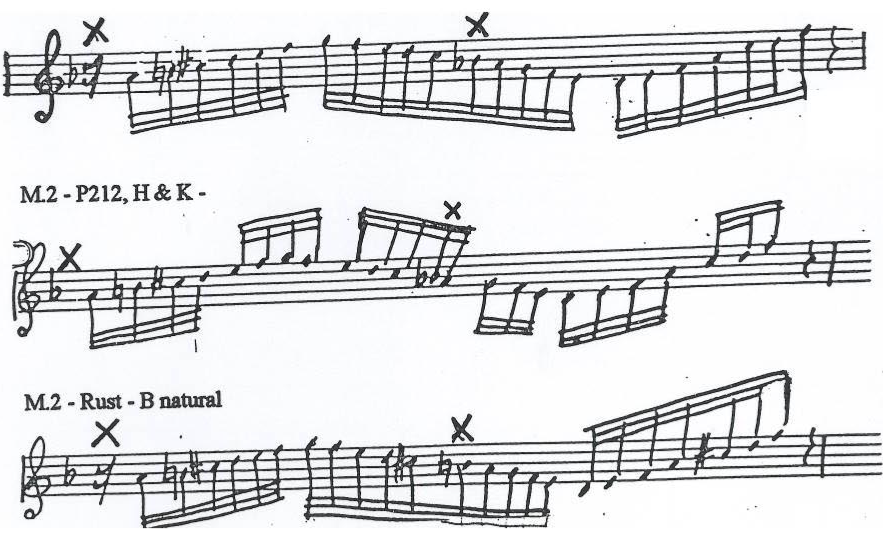
All listed manuscripts and their branches agree with P651 in adding a flat to B each time it appears except P228, and P1083, the printer´s copy, which contain B-flat in their key signature.
M. 5. P651.

Bb – C#, the augmented second, was generally favored.
M. 5. Rust.
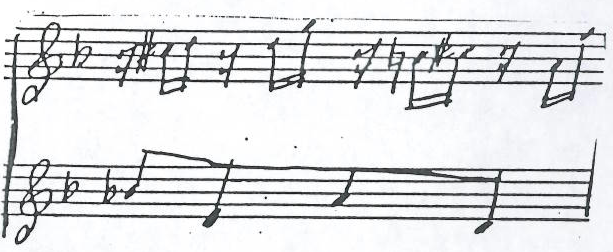
Rust notes B-natural.
M. 19. Fourth beat.
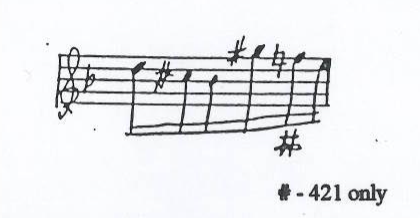
All manuscripts show F-natural except P421, which has it sharped.
Because P421 is an excellent source and the model for the B-G edition, this variant is worthy of particular notice. However, B-G does not conform in this case and selects F-natural, despite its general faithfulness to P421. The interest here lies in the general preference of augmented second over the major second in almost every case throughout the Fantasia. But the scribe of P421 clearly favors the major rather than the augmented second, for the handwriting is firm, the accidentals carefully placed and overall, P421 is a clean copy with very few scratch-outs. The reason for abandoning the augmented second here is fully justifiable on harmonic grounds. The dominant of A-major is leading into its tonic resolution immediately following this upbeat. The F#, the sixth degree of A-major, is therefore in its normal place. The augmented second, caused by F-natural, displaces the entire harmonic progression, virtually annulling the resolving character of the passage.
M. 62, second triplet. Henle.

The Henle edition, 1969/70, has a textual error here, possibly an unobserved printer´s error, repeating the previous D# on the first note of the second triplet instead of the E, which retains the structural pattern of major third followed by a semitone in each triplet figure. Such a variant is not present in any of the listed sources or their branches; moreover the D# possesses no structural validity. All listed and early printings employ the E:
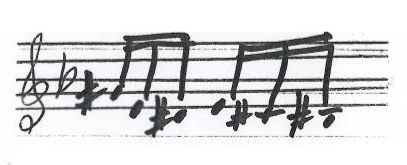
II.A.3. Embellishment
II.A.3.a. Symbols in Mus. Ms. P651
Ms. Ms. P651 employs three basic embellishment symbols: ![]() ,
, ![]() ,
, ![]() the third most frequently, and the Arpeggio indication,
the third most frequently, and the Arpeggio indication, ![]() .
.
II.A.3.b. Variant Chart
The following examples of variant embellishment symbols in the manuscript sources and early printings are significant, for they provide an uncurtained glimpse into individual historical indications that reflect individual performance treatments of these figurations. The varied symbols in the manuscripts therefore mirror eighteenth-century diversity of approach and execution of embellishment in performance; as such, a study of the varied treatments is informative to the musician of later eras.
The art of embellishment, besides being based on a body of basic principles and rules developed over several centuries of composition and performance, is also an art of multiformity as opposed to uniformity. Here the style of embellishment as an art of performance variation of the same or like symbols is seen in its living guise. The examples here demonstrate the range, beyond the written text, of varied and individual embellishment treatment[20].
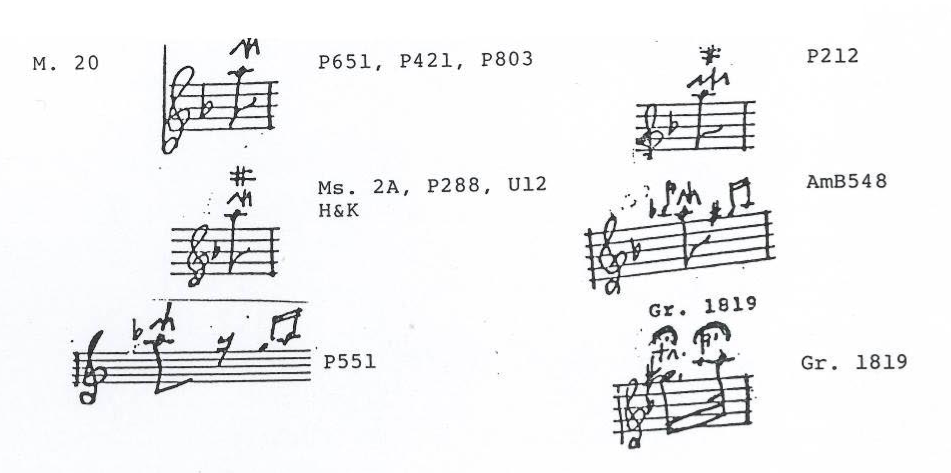
The added sharp representing a specific instruction as to which note is to be employed in performance, throws light upon the use of a semitone in certain embellishment realizations.
II.A.3.c. Added Notes, m. 59
P212 introduces embellishment in the form of added notes in m. 59. These, therefore, are copied in its branch manuscripts, P228, 2a, U12 and enter the printed world of H&K via the printer´s copy, P1983 and are retained in the Griepenkerl 1819 edition as representing Johann Sebastian´s indications. However, none of the other manuscripts add such notes.
The significance of the variants on the first beat of m. 59 is less a matter of textual change than that of performance variance, the embellishment variants being representations of non-uniform embellishment approaches to the same musical situation. The variant of P651 receives inégale treatment in the bass. The tie of P320 represents a style of treating two repeated notes within the comparatively free diction of a recitative section. Am. B. 548 and P212 embellish the first eight but in diverse ways. Accordingly, these particular variants do not represent individual copyist aberrations or slips of the pen, but rather individual performance approaches or impulses generated by the embellishment orientation of the era. Note in m. 59 a departure in text by Gr. 1819, from P212/H&K. This is one of the instances that demonstrate, despite Griepenkerl´s claimed dependence on Forkel (P212), that Griepenkerl departed when he wished from the Forkel version as well as from the note-text of the previous Peter´s plates[21].
II.A.4. The Final Chord
All manuscripts listed in this edition end both the Fantasia and Fugue in the major mode, with the exceptions of P212, two of its derived copies P228 and U12, following P212, and P275 in the Fugue, otherwise derived chiefly from P421. These contain the minor chord and are duplicated in H&K and Gr 1819, due, no doubt, to their basic model, P212. Peters continues to print the minor chords until the middle of the nineteenth century when it capitulated to the major endings.
I retain, in performance, the major ending in both movements as it appears in the most reliable manuscripts. The wavering variance from major to minor third in the manuscript sources reflects the background of the Picardy Third. The principle, so prominent in the sixteenth century, of employing major thirds in final cadences regardless of the mode of the composition, continued to influence the thinking of musicians for a long time. The final chord in both the Fantasia and the Fugue mirror the last rays of this style. Where editors of the nineteenth century impose their taste upon this composition, the minor endings were their preferred ones for nineteenth-century reasons. Bach´s roots, however, were nourished by a past that no longer had relevance after the mid-eighteenth century. The Picardy Third, already by the mid-eighteenth, belonged to history.
M. 79, third and fourth beats.

II.B. Performance Indications in Manuscript Sources
II.B.1. General
Three manuscripts indicate performance devices of interest⎯P887, P551 and P577. P1152, mentioned here only for the sake of completeness, contains copious indications of grossly anachronistic character, entered in another hand from that of the music text; it is unsuitable for consideration in an urtext edition.
P887, a branch of P651, adds fingering as do Am. B. 548/56 and P295. Hand Disposition is indicated in P320. P551 contains: 1) hand disposition, indicated by Sin.- Destr. in the first two measures of the Fantasia, and occasional fingering numerals; 2) a realization of the arpeggio section with simple ascending and descending arpeggios within the original chord range. Textual variants are entered above or below the staff, attributed in each case to Kittel⎯Johann Christian Kittel, 1732-1809.
P577 contains: 1) the same arpeggio realization as P551; 2) hand disposition indicated by L/R throughout the Fantasia in the extended passages; 3) no fingering; 4) one arpeggio symbol in the Fantasia at m. 44, third beat; 5) dynamic indications; pedal indications in the Fugue at mm. 19, 77, 140 and 153.
It is from Mus. Ms. P577 that Ernest Naumann in the B-G extrapolated the dynamic indications f and p as they appear in the manuscript throughout the Fantasia. A sole departure is at m. 58, where Naumann has (f). The symbol in P577 is a little unclear but on close examination it emerges as p. Since this is the only symbol in the B-G placed in parenthesis, it reflects, presumably, the lack of certainty about this symbol in P577.
II.B.2. Stemming and Beaming
The style of stemming and beaming native to polyphonic music forms an image of its structure reflecting the thought of composer. This very notation style presents a particularized structural conception to the performer. If the original notation style of an era is modernized, the structural image germane to the music is destroyed. The direction of stemming, and the placement of beams is crucial to the performer´s perception of the music´s structure. The style of beaming and stemming in the manuscripts of Bach´s time and earlier was based in part writing. Soprano, alto, tenor, bass sustained individual existences and therefore were consistently given their individual appropriate direction in their stemming, with the beaming adjusted to the relationships of the part-writing. To modernize this multi-directional notation style into unidirectional stemming with all the parts in one direction connected with one single beam is to force part writing into a vertical harmonic frame, diverging from the original structural concept and its inherent musical style. Such divergence creates, inevitably, anachronistic performance treatment. Notation styles reflect the structural styles of an era.
II.B.3. Fingering and Hand Disposition
Specific directions for fingering and hand disposition in the manuscripts are discussed here only in regard to the Fantasia.
Fingering: Mus. Ms. P887 is the sole manuscript directly associated with the Bach circle, being a derivative copy of P651, which contains fingering numerals throughout the movement. It is, therefore, of particular interest to the contemporary performer. Different and additional fingering numerals are also present throughout the Fantasia in Am. B. 548 and in mm. 1 and 2 of P295. P551 duplicates the fingering numerals of P887.
Hand Disposition: Indications for hand disposition via stemming also imply fingering. This is evident in P212 and its branches, except Ms. 2a. Sin.-Destr., or S.-D.⎯the Italian equivalent for left hand-right hand, are contained in manuscripts P320, P295 and P551, L.R. appears in Mss. P577 and Ms. 2a. P887 and Am. B. 548 add fingering above and below the note-text signifying hand disposition.
II.B.4. Phrasing
Performance indications being rare in eighteenth-century manuscripts, especially in those preceding 1750, it is to be expected that phrasing/articulation indications appear rarely in the most noteworthy manuscripts of the Chromatic Fantasia and Fugue. Most of the manuscripts add long slurs marks in mm. 1 and 2 of the Fantasia such as appear so clearly in Mus. Ms. P421.
P651 omits the slur on the third beat of m. 2.
The following situations make up about the most one can find in shaping phrases:
- P421, m. 1. One slur over beats 1, 2, 3; m. 2, one slur over beats 1 and 2, and 1 slur over beat; m. 25, 4th beat.
- Mus. Ms P651, m. 1. One slur over over 1st, 2nd 3rd, beats; m. 2, one slur over beats 1 and 2; m. 75, 4th; m. 76, 2nd and 3rd; m. 77, 3rd and 4th beat; m. 78, 4th beat.
- Forkel in his manuscript P212 contributes more generously. Mus. Ms. P212 adds slurs to measure 1; a slur at m. 50, second beat, m. 70, one slur for the 3rd and 4th beats; m. 69, 4th; m. 71, on the 1st, 3rd, and 4th beats; m. 72, 3rd and 4th beats; m. 76 and 77, on the 1st beats and m. 78, 4th beat.
II.B.5. Dynamics. Mus. Ms. P577
Dynamic symbols appear in Mus. Ms. P577, the sole manuscript among the twenty-three that support this study and further ones also, to include the dynamic marks of f and p. Mus. Ms. P1152 is the only other manuscript to include interpretive indications but it is a much later and anachronistic product, and unsuitable for consideration here. Ernest Naumann, B-G, accepts the dynamic marks of P577 and reproduces them. Because of this, and since P577 is unique among the manuscripts by virtue of these entries, it may be useful to examine the style of these entries.
The very act of indicating dynamics, despite the fact that P551, the source of P577, does not contain them, declares the interest of the copyist in performance whether as a teacher, performer, composer or an amalgam of these. Their inclusion is an indication of the scribe´s performance instructions; their very existence may be of considerable value to posterity as an indicator of historical performance applications.
In all times, musicians inevitably carried out in performance some sort of dynamic design, consciously or unconsciously, within the framework of a given medium, for it is virtually impossible to perform on any instrument without any sense of dynamic variety. Despite the fact that the scribe is unknown, these dynamic indications merit scrutiny rather than neglect. In so doing, and antecedent to forming an opinion as to their value, a fair series of pertinent questions would be:
- Do the dynamic indications suit the instruments of Bach´s time?
- Do they fit the structure of the music?
- Do they relate to the style of thought from which Bach´s composition emerged?
- Are these matched by known performance practices and indications previous to 1750?
Responses:
- The dynamic indications in P577 are limited solely to the two dynamic symbols of f and p. It is clear that these indications are germane to the harpsichord, f representing the louder manual, and p the softer manual. Stylistically, this is a familiar effect of the baroque and, practically, these indications conform to a two-manual harpsichord.
Structurally, the f and p appear at moments at which a change in dynamics is virtually mandatory and inevitable: in m.1, f is indicated⎯a hardly arguable dynamic level for this brilliant opening passage of a brilliant and virtuosic composition; in mm. 3-4, the p indication is applied to the inversion of the figuration. The performer is to employ the softer level, which is achieved on the second manual of the harpsichord, to mark the inversion. The contrast of f/p is a respectable performing device to indicate inversion on any instrument and particularly characteristic of the two-manual harpsichord.
No further indications are entered until mm. 13, 14, 15, 16, where f-p is noted for the two instances of repetition. The figures on the third and fourth beats in mm. 13 and 15, repeating the figures on the first and second beats in the same measures are marked p. The return to f in mm. 14 and 16 follows each repeated figure; the f signifies the return to the constant dynamic level of forte.
At the recitative section, the f-p pattern returns to indicate that the chords be played on the louder manual and the meditative melodic figure on the softer manual. A similar pattern of alternation is also applied to the coda⎯the f being applied to the chords on the stronger beats of one-three, and the p to the melodic line on the weaker beats 2-4. One would be hard put to fault the conformity to Bach´s structural designs and relationships in these dynamic patterns.
Besides these, p occurs at mm. 2 and 71-73. They are also based on the compositional pattern, m. 2 containing the same passage as m. 1 but in the dominant. This reiteration in the dominant is an echo of the like passage in the tonic at m.1, and, perceived as such and played in p, echoes the f of m.1. A nice inversion of the diminished chord figure at m. 71, from the second through the fourth beats, occurs in m. 73 from the first through the third beats. The intervening chord and passage at m. 72 is marked f; the passages in direct and inverted motion, p. The contrast of f/p calls attention to this structural nicety and projects aurally the treatment of direct motion followed by the inversion of the figuration.
- The dynamic indications⎯emerging from the two basic harpsichord volume levels of f and p⎯are integrated with the structure of the music and the eighteenth-century instrument. Therefore, they are demonstrably contiguous with the style of thought and performance of Bach´s era. Even if the manuscript was copied after Bach´s death in 1750, these dynamic indications belong to both the instrument and the structural style of the Fantasia. The birth and death of a style are gradual and the outgoing “old” always co-exists with the incoming “new” fashion.
The Echo movement of Bach´s French Ouverture, published during his lifetime in 1735, documents his interest in f/p contrasts. A historical review shows that contrast effects in dynamics was a characteristic of the Empfindsamkeit style in the post-Baroque era. These dynamic entries may suggest that P577 is a product of the period following 1750. The echo effect per se, however, dates well back both as an instrumental device and a performance practice. Purcell employs loud and soft contrasts in his anthems, and organs built after the Restoration in England, France, Netherlands, and Germany, had a built-in echo device known as the Echo Cornet. The Swell pedal, making crescendo/diminuendo possible on the organ, was not invented until 1712; the echo effect was gradually replaced with the use of the Swell pedal but there is evidence that the practice of loud/soft continued as late as 1812[22]. Therefore, the f/p entries may just as easily reflect and older tradition rather than the later one represented by the Empfindsamkeit of the mid- and later eighteenth century. In either case their structural and instrumental suitability are manifest, and clearly the echo effect would have been no novelty to Johann Sebastian. Other possibilities of dynamics exist from those specified in P577 and certain departures from these are even suggested in the edited music score.
A dynamic plan is not provided for the Fugue in P577. Only one f stands alone at m. 147, placed just after the third beat.
It could be argued that, on the harpsichord, shifting from one manual to another was not practiced in Bach´s time. This argument diminishes the bond that links the instrumental means of varied expression to the musical structure and affect. It implies a narrow range of expression as well as structure. The very nature of the harpsichord, even one built with only one manual, is intrinsically involved with a variety of texture, limited though it sometimes may be, and concomitantly a variety of volume by way of registration. To deprive the harpsichord of variety of textures is to leech out its very built-in nature. The music of the Fantasia is founded on a variety of figuration, modulation, extraverted brilliance and introverted meditation. The rich fabric does not require cosmetics by way of overblown registration changes, but a conscious effort to impoverish the variety by narrowing it to a minimal texture is equally unbalanced. Variety of sonorities is implicit in the historical fact that many harpsichords did possess two manuals and variable numbers of additional registrations. Moreover, it is unrealistic to believe that a skilled musician of that time, performing music of the density of that of Johann Sebastian, on an instrument possessing two manuals, would calvinistically avoid the aural delights of contrasting and varied textures, thereby denying the life of the music´s greatly differentiated figurations and the sonorities that the two manuals afford to illuminate them.
In constructs such as the Fugue, I regard the use of one manual appropriate, although a tasteful employment of two manuals, avoiding any distortion of structure, is not to be condemned. Although Carl Philipp Emanuel Bach bestrode his father´s world with one leg and the modern world of the galant period with the other, a careful sifting of the voluminous information in his Essay yields the following interesting statement:
There are certain general rules that govern the performance of forte and piano on the organ and the two-manual harpsichord: fortissimo and forte are played on the louder manual… in…piano both hands use the softer manual
(C.P.E. Bach, Essay: 369)
II.B.6. Arpeggio
II.B.6.a. The Arpeggio Symbol. Mus. Ms. P651
![]() is employed in a number of the manuscripts considered here. Those in the principal manuscript source, P651, occur in m. 60, 3rd; m. 68, 1st beat; m. 69, 3rd beat; m. 74, 4th beat.
is employed in a number of the manuscripts considered here. Those in the principal manuscript source, P651, occur in m. 60, 3rd; m. 68, 1st beat; m. 69, 3rd beat; m. 74, 4th beat.
II.B.6.b. The Arpeggio Section. Mus. Mss. P551, P577
The verbal instruction “arpeggio” appears unanimously in the principal manuscripts in m. 27 on the 3rd beat, at the first half-note chord. Mus. Ms. P551 adds an arpeggiated realization of the entire section m. 27 through m. 40, which is copied into P577. The style of arpeggiation is essentially a simple outline of the chord ascending and descending one within the original range of each chord.
III. Notes on Text: Fugue. Variants in Principal Manuscript Sources
III.1. Note-text
Consideration here of specific variants in the note-text is concentrated, as in the Fantasia, on four principal sources⎯P651, P421, P212, P803.
The eighth-note figure in m. 4 of the fugue subject receives varied treatment throughout the Fugue. The original figure is shown at a); the variant treatments are shown at b) and c). The slight orthographic change at b) is structurally inconsequential. However, c) is significant.

The variant readings involving c) occur in mm. 45, 63, 93, 134, 157.
M. 45

The last eighth of the figure functions as a passing tone⎯its removal causes the deletion of this function. At times this choice may be dictated by contrapuntal and/or harmonic considerations.
At m. 63, third beat, the a) version produces the interval of a seventh at a moment of dubious desirability on the second eighth, with A-natural in the alto against B-natural in the bass. Worse still, it produces a double pair of paralleled fifths. The first pair of hidden fifths (relationship of G-C# and A-D) appears by virtue of the main notes of the figures in each part. The second pair are explicit parallel fifths, formed by A with the last thirty-second of the embellishment figure, a Schleifer, in the bass on D, and the first downbeat in the following measure. This double succession of parallel fifths is avoided by all four manuscripts⎯P651, P421, P212 and P803, which employ the c) version.
At m. 134 a) would cause a triple repetition of D in the tenor, within the time span of three consecutive eighth note values, hardly a desirable linear procedure. It would also weaken the stringent effect of the diminished chord on the first beat of m. 135.
At m. 157, parallel diminished sevenths become explicit; omitting the passing tone veils the effect somewhat, with hidden sevenths.
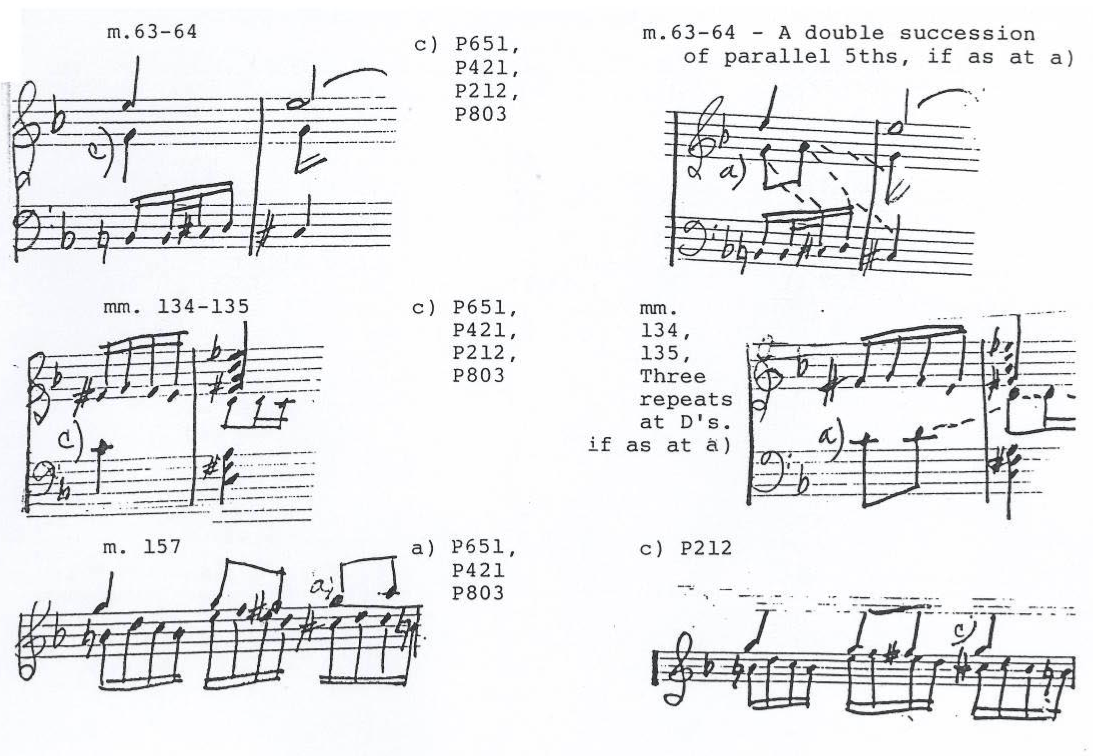
The net result of the variance in this figure: P212 is consistent in retaining c) in all three measures thus differing from P651 in two cases at mm. 45 and 157. P651 and P421 differ from each other only in m.45, and both differ from P212 at m. 157. P803 is the only manuscript that agrees consistently with P651.
This variant, stemming from P212 and its branches, has been transmitted through the nineteenth-century editions via the Peters editions⎯H&K, Gr., 1819 and Czerny. An interesting parallel treatment occurs in mm. 128, 129, 130, where these two upper voices are inverted; in these measures, the principal manuscripts agree with this version. The variance in these editions, urtext and otherwise, is due to the above manuscript divergences.
M. 92, third beat.
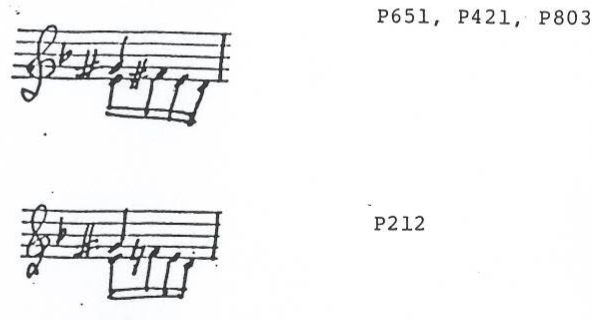
M. 108, fourth beat.
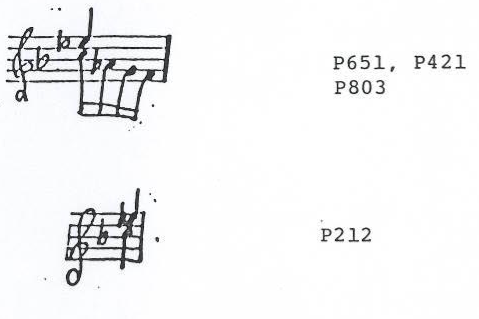
M. 109, first beat.

M. 161. The final chord (See also II.A.4 above).
The ending with the major chord, followed by the low bass note, is the agreed version as manifested definitively in unanimity by the best manuscripts.
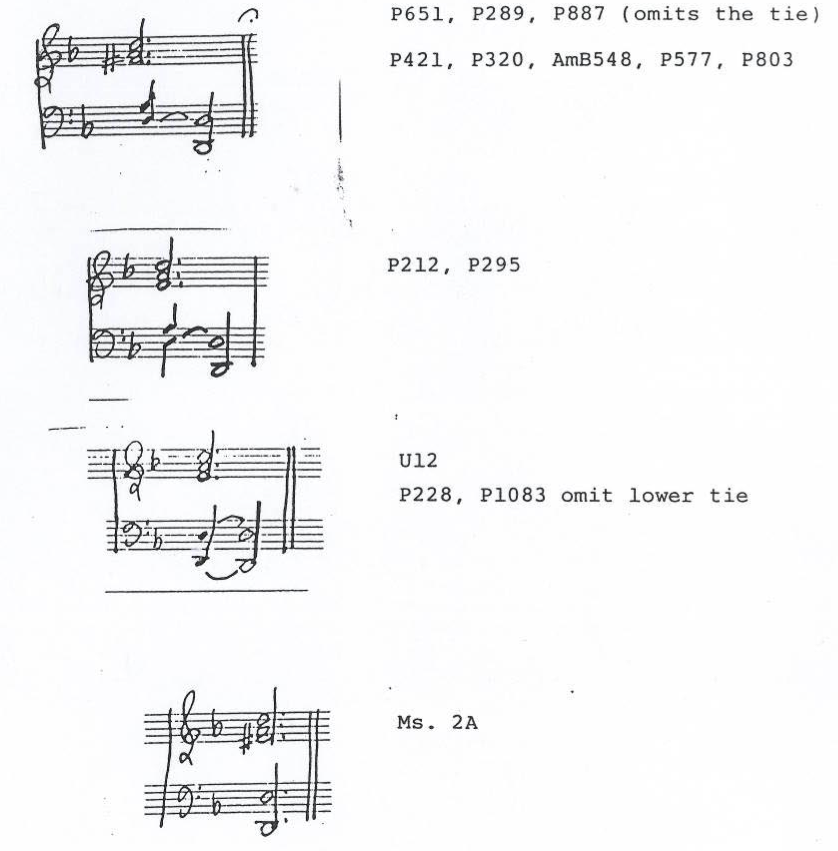
III.2. Embellishment
III.2.a. Symbols
P651: The entries of embellishment symbols in P651 are limited to ![]() (the long trill),
(the long trill), ![]() (the mordent) and
(the mordent) and ![]() (the Schleifer).
(the Schleifer).
P887, one of its branch manuscripts, has more entries but they are also confined to these three embellishments.
III.2.b. Written-out Embellishments
Occasional realizations of embellishments are written in staff notation:
- The Nachschlag (after-beat) following a trill occurs at m. 24 and in m. 35 in the soprano, m. 71 in the alto.
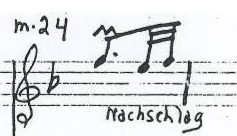
- The Schleifer, m. 42 and 64 in the soprano, m. 63 in the bass.
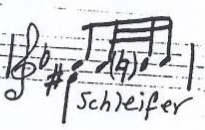

III.3. Phrasing Slurs
Agricola, in P651, offers few articulation clues in the Fugue. Unlike in the Fantasia, the sole entries being tow-note slurs. These occur at mm. 46, 64, 66, 80, 81 and again for the same two-note figure at mm. 144-145. These are identically indicated in P803. P421 follows P651 except in mm. 64, 81 and 145. P212 enters slurs only at mm. 144-145.
IV. Comments on Performance
IV.A. Fantasia
IV.A.1. General - Harpsichord and Piano
The following comments are based on the view that a) historical knowledge and its ever-widening pursuit is essential to the art of performance of Bach´s music; b) it is desirable that the modern pianist be well versed in the techniques involved in harpsichord playing with experience in actual performance on this instrument; also, c) that conscious awareness (which requires some degree of investigation) of the musical habits and expectations of modern times be heightened in order to more objectively disentangle modern musical impulses from the imperatives of seventeenth and eighteenth-century musicianship.
For performance on a modern instrument, efforts to reproduce an eighteenth-century instrument produce simplistic imitations and are altogether too superficial an approach toward authenticity. A clear understanding of form and structure in all its subtle ramifications is essential. If an anachronistic sense of phrase gives shape, and if structural relationships as well as dynamic patterns, embellishment treatments and registrations are applied to harpsichord performance, the result is as unfitting to the music as it is to the instrument. The deeper and more subtle the insight into structure, the closer is one´s capacity to identify with it and shape it according to its own unique design, avoiding distortions from alien styles, aural musical habits and anachronistic performance applications. In addition to wide-ranging historical studies, stylistic musical performance therefore involves embracing, over and beyond the instrument, the essential musical and stylistic factors emerging from structural factors plus performance technical skills and an ever-deepening insight into the conceptual world of the composer.
IV.A.2. Dynamics – Fantasia and Fugue
IV.A.2.a. General
A clear framework of forte and piano can easily be maintained throughout the Fantasia and Fugue on either the harpsichord or the piano without becoming pedantic. The suitability of alternating forte and piano should be based on the structure of these movements, historical performance practices and the nature of the harpsichord. The dynamic indications in P577 are not unfitting structurally, generally appearing at suitable musical junctures such as repeated figures or contrasting structural devices (See: IV, B, 4). They also suit the characteristics of the harpsichord and the practice of the echo effect of the forte/piano characteristic of Baroque style. These dynamics recommendations are apt, but the scribe is unknown, and lacking an autograph, the contemporary musician must make individual decisions as to whether and to what extent, to employ them.
IV.A.2.b Harpsichord – Registration – Fantasia and Fugue
One of the charms of the harpsichord of the eighteenth century is the variability of sonority and registration from country to country and maker to maker. This variability produces changes in the tonal balance of registrations of the manuals, from harpsichord to harpsichord. No period harpsichord can be singled out as “the right harpsichord”. As a result, a rigidly prescribed program of dynamics for harpsichord performance is, to a large extent, inapplicable. This divergence of tonal balance and relationships would not have encouraged the entry of precise performance indications by Bach and others. Variety still exists today from maker to maker of modern harpsichords, depending on their chosen models, materials used in manufacture, individual performers´ specifications, etc. For these reasons, and to allow for the individual performer´s background and taste, the editor presents general recommendations here, based on historical structural and instrumental factors, leaving individual registration up to the performer.
Registration – Fantasia: For forte, especially in the long virtuoso passages, the combination of 8´and 4´on the “loud” manual is generally desirable. Depending on the instrument and the room in which the performance takes place, the coupler may be useful. For the forte in the alternating forte/piano within the recitative section, the editor finds the coupler usually too heavy and thick. This is likely to be true for the coda as well. From m. 61, 4th beat, through the end of the m. 62 an inversion that is too good to miss is effectively etched by an abrupt change of manual from piano to forte. Finally, in general, each individual paired with a particular instrument must choose a suitable framework of related sonorities via registration and choice of manuals throughout.
Registration – Fugue: The editor prefers not to apply the coupler at all in the Fugue for the sake of greater clarity of the parts and an overall transparency of texture. Few or no registration changes work best here.
IV.A.2.c. Piano – Fantasia and Fugue
In the absence of any direct original association of this composition with the piano, the task of the modern performer on this contemporary instrument devolves on basic issues of musical performance: understanding of the form and structure of the composition, historical performance practices, keyboard characteristics of the instruments native to the composer´s era, and a piano technique that is suited specifically to all of these facets of Bach´s music.
The conscientious pianist would do well to follow dynamic patterns based on forte/piano. The “pianistic” style of recurrent crescendo/diminuendo has no place in the structural scheme of either the Fantasia or the Fugue. Contrary to general practice, the piano is capable of dynamic approaches quite different from the habitual one of the rising and falling volume representing nineteenth-century structures and pianism.
The pianist must learn a new kind of control of sonorities for Bach performance. For instance, from the first note through the last note of a phrase or passage one should forego the conventional pianistic tendency to begin softer, peak to a crescendo, and/or end it with a relaxing curve of a diminuendo. The pianist who knows only this traditional, limited technique of dynamics will seize on the ascending, descending passages in the Fantasia as a vehicle for personal virtuoso display. However, the virtuosic effect is not lost at all with otherwise structured dynamics⎯quite the contrary: dynamic designs that emerge from the basic structural design illuminate not only the structure, but they also highlight the virtuosic tonal control of the performer imparting a sense of fittingness.
For example, mm. 3 through 20, 21 through 27, 27 through to the third beat of m. 49, etc., are contained within a unified harmonic and figurative structure. To assign an accordion treatment to dynamics to them just because individual figurations ascend and descent is to distort the entire architecture of the movement. A careful study of the harmonic form of the movement will clarify the pillars upon which this movement is built. It is incumbent upon a performer on any instrument to preserve these harmonic supports. Given the way Bach structured these sections, crescendo/diminuendo is likely to destroy these supports. This does not cancel out means of expressiveness or brilliance⎯long and speedy passages in sustained forte or piano can be very brilliant⎯ but it does make mandatory a performing style that matches the original structure of the composition. This also does not eliminate the advantages of the piano in its capability for shaping phrases in microtonal relationships. But the large supporting structure must not be deranged or obscured by performing devices that are alien to it. With this in mind⎯added to which is consideration of the historical imperative⎯ it will be seen that the forte/piano technique of dynamics is applicable to both the Fantasia and the Fugue on the piano (See IV.B.2 below).
IV.A.2.d. Recitative: mm. 61-62
In the beautiful meditations of the recitative, the pianist can take advantage of the singing, expressive capabilities of the piano. However, the relationship of the downbeat chords to the melodic figures in the top part must be preserved with the same sense of alternation between these two elements, as does Bach in his persistent continuation of their differentiated aspects throughout the recitative. The forte treatment of the chords is very fitting in contrast with the quieter, melodic line; some tasteful variety here will not, however, injure the frame of the recitative section, when one´s feeling and understanding about the harmonic configuration support this kind of tonal variety.
From the 4th beat of m. 61 to the 2nd beat of m. 62 and from thence to the end of the measure at the trill, Bach gives us an intriguing inversion within the first virtuoso passage following the recitative. This inversion has gone unnoticed in many performance editions. For this reason the editor highlights the abrupt about-face of the direction of the passage following the downbeat at the second beat of m. 62, with an abrupt dynamic change⎯from piano to forte. The inversion of dynamics fits the inversion of the figure, and the dynamic pattern of piano/forte integrates with the preceding and following dynamic patterns throughout the Fantasia. Because it is so deeply imbedded in the structure, this works for both harpsichord and piano.
IV.A.2.e. Coda
The same applies to the dynamic treatment of the Coda. A continual diminuendo to the end in the manner of a dying swan (often seen in performance editions) is utterly alien to this structure. Nothing in this coda suggests a thinning of texture⎯quite the contrary. The chords become more dense and richer in textures with the extension in range of the organ point to the low bass from mm. 77 to the end. The dynamic pattern established at the beginning of the coda should be retained unswervingly to the end just as Bach retained the structural pattern throughout the coda to the end.
IV.A.3. Embellishment
IV.A.3.a. Realizations – mm. 20, 59, 74, 79
![]() or
or ![]() are not rigidly limited to four or three notes. Although this number of notes forms the basic performance treatment of these symbols, departures to a longer dimension do occur. Structural considerations must be added to conclusions regarding embellishment realizations. A longer ornament may be considered here. The arrival on the dominant, in the first breathing point since m. 2, invites emphasis and a moment´s breath in mid-flight; a longer ornamental realization may be a worthy alternative to the clipped three-note ornament.
are not rigidly limited to four or three notes. Although this number of notes forms the basic performance treatment of these symbols, departures to a longer dimension do occur. Structural considerations must be added to conclusions regarding embellishment realizations. A longer ornament may be considered here. The arrival on the dominant, in the first breathing point since m. 2, invites emphasis and a moment´s breath in mid-flight; a longer ornamental realization may be a worthy alternative to the clipped three-note ornament.
M. 20

M. 59. Embellishments are appropriate on the first and third beats. Compound embellishment is present in Forkel´s Ms. P212:
First beat Third beat
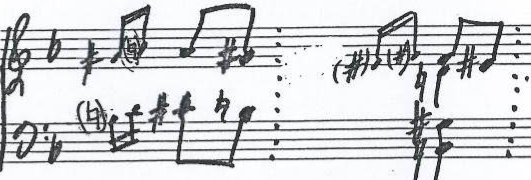
Other possibilities exist. A recommended option is:
First beat Third beat
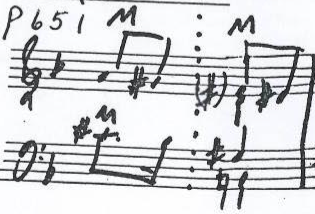
First beat Third beat
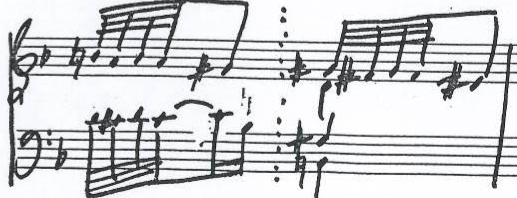
M. 74. An embellishment, appoggiatura cum passing tone, or short shake is appropriate as a means of linking the interval of a third beat to the fourth beat, in conjunction with the arpeggiated chord.
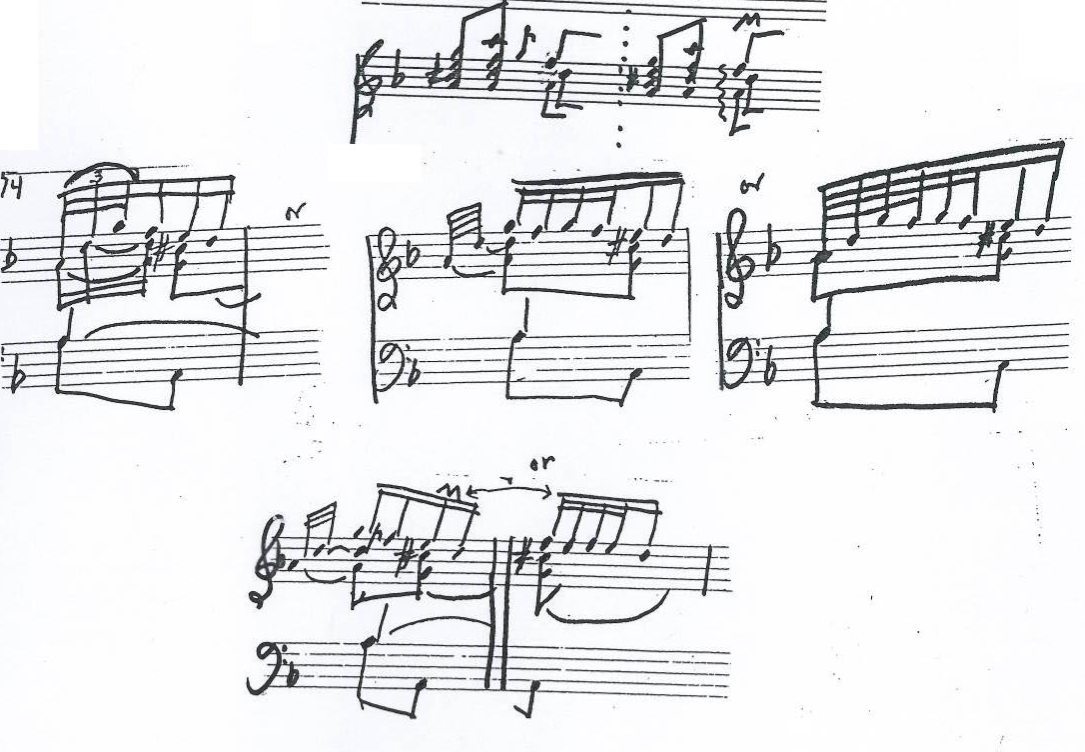
IV.A.3.b. Appoggiature – Recitative
The appoggiatura is a consistent feature of the recitative section. Beginning with the opening of the recitative, it appears as a written-out two-note figure of eighths on the second beats of mm. 50 and 51, and reappears throughout this section, always in staff notation. To be aware of the two-note figure as a main note paired with its preceding appoggiatura contributes a subtle enhancement to the expressiveness of the entire recitative section.
IV.A.4. Piano Pedaling
It would seem hardly necessary to say that sustained long pedals are inappropriate for either the brilliant, fast moving passages of the Fantasia or the articulated contrapuntal lines of the Fugue. However, one may take advantage of certain functions of the piano pedals, always preserving, however, total respect for clarity of structure. Pedal through each progression of the arpeggiated figurations in the arpeggio section is appropriate; judicious single pedals for chords and for emphasizing a harmonic resolution or a singing melodic line as in the recitative section of the Fantasia are enhancing without doing any injury to the original musical patterns.
IV.A.5. Touch on the Piano
A smooth pianistic legato in the long passages is unstylistic. It belongs to the “string of pearls” of the classical school⎯and the “spianato” of romantic-virtuoso piano playing style as in Chopin. Non-legato here is essential for greatest clarity and brilliance. The degrees of non-legato vary⎯the triplet figure in sixteenth notes is brilliant when quite detached; the long passages in thirty-second note values are equally so when still detached but in a lesser degree. Therefore, a strong finger action is desirable for the brilliant passages of the Fantasia. The recitative and the coda obviously plead for a singing legato style. This need not produce sentimentality, but rather aids in expressing the sentiment of a deep, meditative statement, which is the essence of these two sections.
The chromaticism of the Fugue´s subject lends itself to a legato touch. This can alternate very effectively with varieties of detached touch in the episodes throughout the Fugue.
IV.A.6. Fingering – Harpsichord and Piano
Styles of fingering applications on keyboard instruments vary in different musical cultures. Fingering notation is generally expressed in arithmetical numerals and therefore poses little or no problem for contemporary intelligibility and usage. Hand disposition via stemming directions or sinistra/destra, meaning left hand/right hand or L.H. are equally communicative and carry implications for fingering as well.
Fingering must be maximally comfortable physically in order for the fingers to achieve spontaneous fluidity. Co-equal with physical comfort in importance is rhythmic evenness, reflecting accurate time values and rhythmic patterns and supporting clarity in the articulation of phrasing. On both historical and modern instruments, clear distinctions between sustained touch for short or long slurs, and varied degrees of detached or short staccato touch are mandatory for achieving clarity in projecting the multiple figurations contained in dense contrapuntal structures. Fingering choices must be attentive to such structural factors. In assigning hand divisions and fingering, the editor has given consideration to preserving the structural rhythmic figurations of the passages as well as the tonal relationships at the points of hand division.
Harpsichord fingering: The fingering style in Mus. Ms. Bach P887 represents conformity to the light action of the harpsichord manuals. According to its fingering entries the sparse use of the fifth finger encourages active use of the fourth finger. Furthermore, it can be seen that the copyist felt no compunction about placing the fifth finger on the black keys, a practice usually tabooed by nineteenth-century fingering systems and usually avoided today by pianists (See IV, B, 2).
Piano fingering: The heavier action of the modern piano discourages duplicating the harpsichord fingering of P887. For instance, for piano performance, the use of the fifth finger of the left hand on white notes at the beginning of extended passages is often preferable to the weaker fourth finger. Although the fifth finger on black notes can be very useful and need not be avoided altogether, it must be employed with care for it is, in some hands, limited in tonal control, and tends to sip, especially in fast passages.
The size and comfort of individual hands and the difference in the width of harpsichord and piano keys must also be taken into account. Performers and teachers who are skilled in the techniques of both the harpsichord and the pianoforte will understand that fingering requirements differ on these two instruments.
For these reasons, judicious adjustment of the harpsichord fingering in P887 is desirable for performance on the piano. It would be pedantic to adhere rigidly to the fingerings of P887, despite the fact that its text derives from P651, if reasonable alterations work better for the individual performer and instrument. The fingering in P887 is well workable for the harpsichord.
In this connection, a quotation from Praetorius is apt:
Many think it a matter of great importance, and despise such organists as do not use this or that particular fingering, which in my opinion is not worth the talk; for to let a player run up or down with either first, middle or third finger, aye, even with his nose if that could help him, provided everything is done clearly, correctly and gracefully, it does not much matter how or in what manner it is accomplished
(Syntagma musicum, 1619)[23]
IV.A.7. Realization of Arpeggio
IV.A.7.a. The Arpeggio Section – mm. 27-49
IV.A.7.a.1.Sources
One of Carl Philipp Emanuel´s instructions for performance of arpeggio is: “The word arpeggio written over a long note calls for a chord broken upward and downward several times…the asterisked example represents an arpeggio with an acciaccatura” (C.P.E. Bach, Essay, 159).
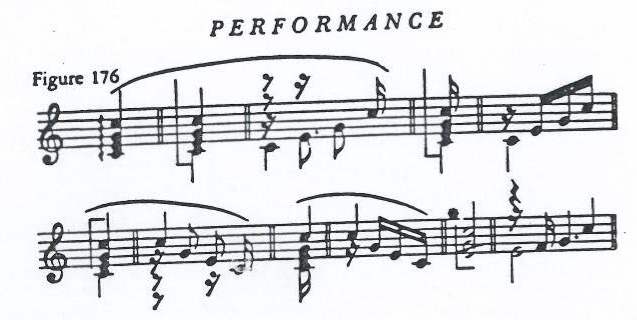
The instruction and its illustration contain several significant implications. The verbal instruction clearly says arpeggiated chords are 1) to be performed upwards and downwards, and 2), expected to be broken in ascent and descent more than once. The illustration demonstrates that the arpeggiated chords begin on the beat. Philipp Emanuel´s above quoted rule refers in this instance to a single chord. His precepts for treating a series of broken chords are introduced and elaborated in the chapter on improvisation:
The beauty of variety is made evident in the Fantasia. A diversified figuration and all attributes of good performance must be employed. The ear tires of unrelieved passage work, sustained chords or broken chords. By themselves they neither stir nor still the passions and it is for these purposes that the Fantasia is exceptionally well suited…All chords may be broken in many ways and expressed in rapid or slow figuration. Broken chords in which principal as well as certain neighboring notes are repeated are especially attractive for they are more varied than a simple arpeggio where tones are played successively just as they lie under the hands.
(C.P.E. Bach, Essay, 438-439) [Rosalyn Tureck´s emphases]
Friedrich Conrad Griepenkerl, student of Forkel and editor of the first performance edition (Leipzig, C. F. Peters, 1819) comments on the arpeggio in his Preface:
The arpeggios indicated by chords in white (i.e. half) notes should, according to C.P.E. Bach´s instructions in his work on the true art of playing keyboard instruments, be played up and down twice on each chord with the fingers remaining on the keys. We think it better to play each chord up and down only once, and the final chord in each arpeggio series only up once.
(Griepenkerl, Compositions, ″Vorrede″)
It is clear from these seminal sources that the number of times of ascent and descent was flexible: P551 and its branch manuscript P557 prescribe ascent-descent once, Griepenkerl once and C. PH. E. Bach “several” times. Although C.P.E. Bach partook in certain areas, of a style later than that of his father, his orientation involving improvisation was rooted in practices of the baroque, and florid improvisation is one of the trademarks of the baroque.
IV.A.7.a.2. Analysis of Form and Structure
The new features are founded on the harmonic and rhythmic elements in the structure of the entire movement of the Fantasia.
This movement is composed, indubitably, in an improvisational style, yet Bach´s sense of form and structure never abandons the essential framework of a composition, even one as free as this is, to amorphous harmonic or rhythmic treatment at any point. Analysis of the structural elements in the Fantasia reveals the usual rock-like form that underlies all his compositions. Accordingly, the arpeggio section is not offered simply as an ornamental contribution by the performer The harmonic relationships within the section consolidate the development of the section and therefore deserve better than the undifferentiated ebb and flow of repetitive arpeggio outlines from which this section has suffered for a very long time throughout the nineteenth century, and in the twenty century as well. Even more crucial is the relationship of this section to the harmonic structuring of the entire Fantasia[24].
The harmonic analysis of the Fantasia shows that, after the establishment of the tonic key in mm. 1 and 2, modulation begins at m.3 and continues throughout the following twenty-four measures without once effecting a full cadence in the tonic key. At m. 27, simultaneously with the opening measure of the arpeggio section, D minor comes to rest on the tonic root in the bass and the tonic key is at last re-established for the first time since m. 3.
At this moment Bach abandons the harmonic excursions of the opening section and begins modulation anew from the solid base of the re-established tonic, concentrating on a clearly defined ascending chromatic progression continuing for four measures to the dominant, mm. 27-30. The return to and consolidation of the tonic key at the opening of the arpeggio section, and the embarkation anew upon a new set of harmonic progressions, modulating again away from the tonic, is a clear reference to the opening of the Fantasia, a return to the beginning. From m. 3 to m. 27, the main style of harmonic progression has been diatonic. From the renewed establishment of the tonic at m. 27, the main style of modulation is now chromatic.
IV.A.7.a.3. Realization on Harpsichord and Piano
Instead of imposing a static repetitive arpeggiation to so significant a moment in the composition, just s Bach returns to the beginning in the strong restatement of the tonic key, the editor returns to the same rhythmic and figurative pattern employed in the beginning. In so doing, the elements of the opening are restored and the structural relationship with the opening statement is clearly identified and heard. A repetitious pattern of arpeggiated chords obscures this powerful return to the tonic. The clarification of the return is doubly indispensable here because the tonic key is not re-established again in a full cadence from this point until mm. 74-75, a total of 47 measures of consistently modulating materials in a composition 79 measures long, virtually half of the work.
Referring now to the strategic placement within the Fantasia of this arpeggio section, the return to the tonic-underlined by the outlining of the tonic chord at m.26 and its arrival in the tonic position in the bass at m. 27⎯forms a central pillar in the harmonic architecture of the whole composition, upholding as well its decorative content.
The final return to the tonic, occurring at mm. 74-75, forms the third harmonic pillar of the movement. These relationships require notice. For the central section, the restoration of the opening rhythmic pattern with the returned tonic key provides the recognition and sense of identification with the initially established harmonic base and rhythmic structural momentum. Three harmonic pillars, then, uphold the wandering improvisational passages and modulations⎯at mm. 1-4, mm. 25-26, mm. 74-74 to the end.
For these reasons, I employ Bach´s own rhythmic motive for the opening of the arpeggio section and structure the rest of the arpeggio realizations accordingly.
On Harpsichord:
Bach utilized the following device for means of lengthening single tones. That he required, at times, long sustained notes within moving passages is clearly demonstrated in his notation of such works as the Prelude in F minor BWV 857 from The Well-Tempered Clavier, Book I, where the first note of each phrase (consisting of four eighteenth notes) is assigned a quarter-note value.

Another inescapable example is the Sarabande from the Partita in C minor BWV 826.

The kaleidoscopic, changing harmonic progression does benefit by holding through particular single tones; they aid voice leading and clarify harmonic relationships: viz. mm. 40 and 44 in the Fantasia where Bach interrupts the performer´s contribution by specifying the quarter notes E-D-C# and C-B respectively in the alto part. The following A in m. 45 completes the linear element C-B-A, as well as the harmonic element of diminished and dominant sevenths resolving in the A minor tonic, and this should be made clear in performance. Bach also guides the performer in m. 33, with quarter notes in the soprano and in m. 46 in the bass. From time to time the entire chordal configuration may be held with the fingers, with each hand successively sustaining the chordal outline and, occasionally, but more rarely, both hands doing so concurrently. I favor such treatment in my arpeggio realizations, and the performer can exercise individual taste as well, always keeping in mind the essential original structure.
At m. 37 to 42, with the change in figuration, I recommend a very light, detached touch ending on the second beat of m. 40. A change of manual from the “louder” to the “softer” at m. 37 on the first beat makes for an exquisite textural contrast with the preceding chordal section; the harpsichordist can enhance this with some degree of staccato touch, and may choose to adopt the change of pace from active figurations as shown in mm. 40 and 44 of the piano realization.
In m. 31, an acciaccatura is attractive for harpsichord performance.
On Piano:
Similar considerations apply to performance on the piano: for instance, sustaining the moving linear figurations with the fingers, rather than endangering the line with smudges from the sustaining pedal. However, the use of the pedal is enhancing and not destructive, when applied to the arpeggiation with care for the purpose of retaining the clarity of the chordal outline and avoiding smearing the dissonances and acciaccatura. At m. 37 to 42, a clearly defined, light, near-staccato on the piano provides a particularly defined felicitous transparency of texture following the preceding richer texture of the lower-lying chords.
At mm. 40 and 44, a change of pace for two beats interrupting the continuous active figurations is very beautiful, particularly if played with a sense of the rhythmic grandeur of these moments.
IV.A.7.b. Other Arpeggio Applications
The chords from m. 50 to the end of the Fantasia may receive a variety of arpeggiated patterns. One decision is already given to us in written-out notation. At m. 58, the thirty-seconds are a written-out arpeggiated chord with an appoggiatura on the second beat. At m. 61, the same is written out on the second beat in the upper part. I recommend carrying out this given pattern arpeggiating once upward from the bass⎯on all chords from m.50 until the third beat of m. 61. The chord on the third beat resolving in C-sharp minor, forms a swivel point for the return to brilliant virtuoso passages for the first time since the opening of the recitative section. Therefore, a recommended treatment is:
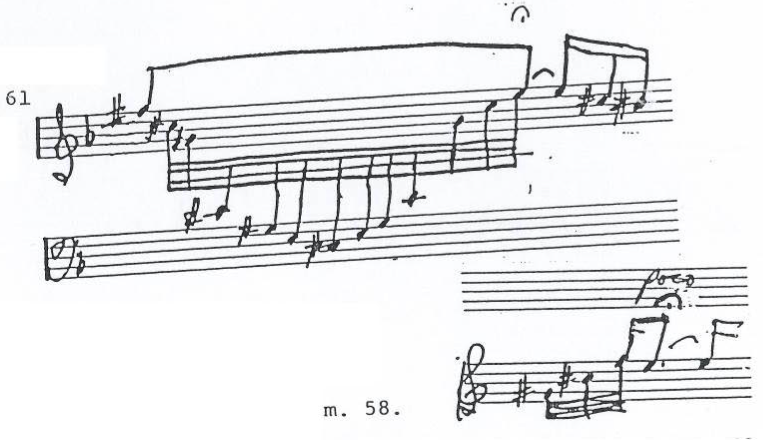
Or with the repeated F-sharp, which is a written-out appoggiatura to E, in the like manner as shown in m. 58.
The arpeggio symbol for the top chord only at mm. 68 and 74 appears in both P651 and P421 as does the extended symbol in mm. 60 and 69 from the bass chord on the third beat through the entire chord in the treble. These arpeggio indications present an example to posterity of varying arpeggio treatment at close range and within the same section. At m. 70, third beat, and m. 72, second beat, the editor recommends the same style of arpeggiation as at m. 69, third beat.
The Coda – m. 75 from the third beat to the end. A variety of choices present themselves for the arpeggiation pattern in the chords here[25]. The advantage of the arpeggiation treatment in this realization lies in the preservation of the beautiful appoggiatura/slur figure noted by Bach in the soprano part. Additionally, the descent/ascent treatment fleshes out the time element of the soprano, filling in the duration of the semi-quaver with the rich harmonies of the seventh chords.
The rhythmic treatment I apply in performance is (a) particularly effective on the harpsichord. On the piano, an even-valued arpeggiation is preferable, shown at (b). Alternative choices may also be recommended for arpeggiation in one direction from bass to top:
- Arpeggiate the bass chords only.
- Arpeggiate the chords in the treble only.
- Arpeggiate treble and bass chords every 1st and 3rd beat.
- Arpeggiate bass chords on 2nd and 4th beats only.
My embellished version of the melodic line in the soprano or the original unembellished line will fit in with any of the above alternative choices.
If 1) is chosen, the bass chords on the 2nd and 4th beats may be played either straight or broken. If 2) is chosen, retain the pattern of arpeggiation on the first and third beats.
M. 78, 3rd beat. As the last chord, the performer may choose still a more extended pattern of arpeggiation.
The clarity of the chromatic scale descent and the strong rhythmic arrivals on beats one and three in each measure should be preserved throughout the Coda, no matter what pattern of arpeggiation is adopted.
IV.A.8. The Fantasia Concept
IV.A.8.a. Form
Fantasia represents a style rather than a set form. Emerging from several centuries of development from the interchangeable styles and titles of Toccata, Fantasia and Ricercare (from “ricercare, to search), which pointed up fugal procedures, the Fantasia often set off its “searching”, improvisational, virtuoso figurations and wandering harmonic progressions with an equally searching but more contemplative middle section in fugal treatment. Stricter fugal form came to be associated as a separate movement with Fantasia, fashioning a maximal contrast in the relationship of two movements joined together in a single composition.
IV.A.8.b. Performance Style
The Fantasia is essentially a thoroughgoing improvisation reflecting Bach´s unbounded fertile imagination, as in the organ Toccatas. Too often this characteristic is neglected and a uni-level virtuoso performance results, blunting its improvisatory nature implanted within a powerfully structured foundation. The performer should keep in mind the exuberant character of the virtuosic passages and the meditative inward musing of the recitative and the coda⎯all written as though improvised on the spot. But also the great harmonic pillars that uphold this freedom of exuberance and introspection must be ever present along with the alert sense of the harmonic progressions and modulations.
Outside of the recitative and the coda, few embellishment additions are called for in a work replete with such decorative written-out figurations as the great rhapsodic passages The arpeggio section, which Bach turns over to the performer, and the coda give ample opportunity to the performer to participate in the embellishing process.
IV.B. Fugue
IV.B.1. Embellishment
Most embellishments are indicated by symbols. However, it is worth noting that in all listed manuscripts two embellishments are written out in staff notation in thirty-seconds. These are a written-out Nachschlag in mm. 24, soprano, third beat; 35, soprano, third beat, 71, alto, third beat, and a written-out Schleifer in mm. 42, soprano, third beat and 63, bass, third beat.
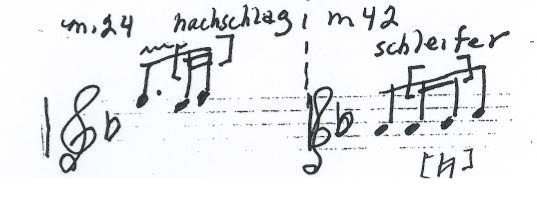
IV.B.1.a. Realization of Symbols
- M.13. Long trill. I favor a Nachschlag at the end of this trill.
- M. 24, third beat. For
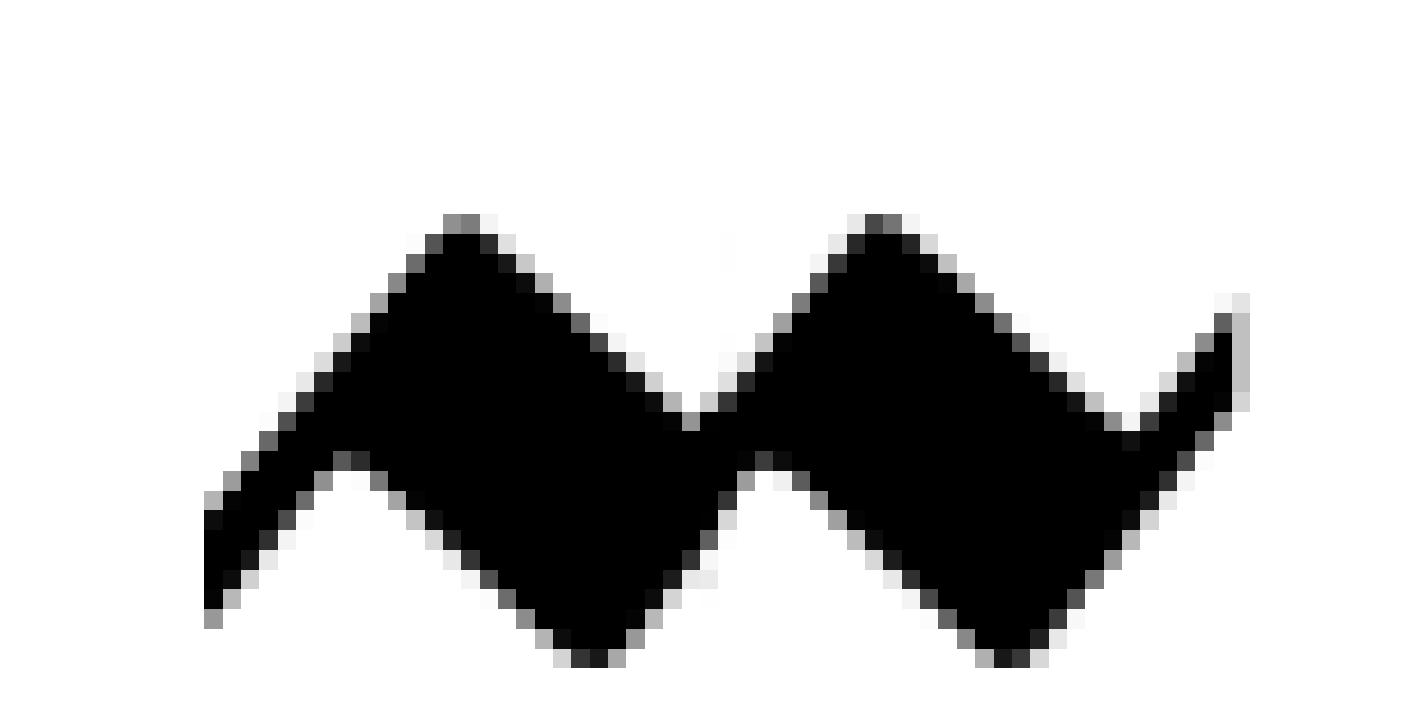 , P651 suggests a four-note shake; its two derivative copies, P289 and P887, propose a longer one, as does P421. The final decision as to the number of notes in the shake rests with the performer´s assessment of the structural situation.
, P651 suggests a four-note shake; its two derivative copies, P289 and P887, propose a longer one, as does P421. The final decision as to the number of notes in the shake rests with the performer´s assessment of the structural situation. - Mm. 46 and 64, Schleifer. These measures parallel each other. It is tempting to speculate on how far Bach was aware that these parallel readings occur in these particular measures of inverted numbers 46-64. The Schleifer in m. 46 is written out in staff notation, in inverted rhythm in m. 64.

Mus. Ms. 651 shows 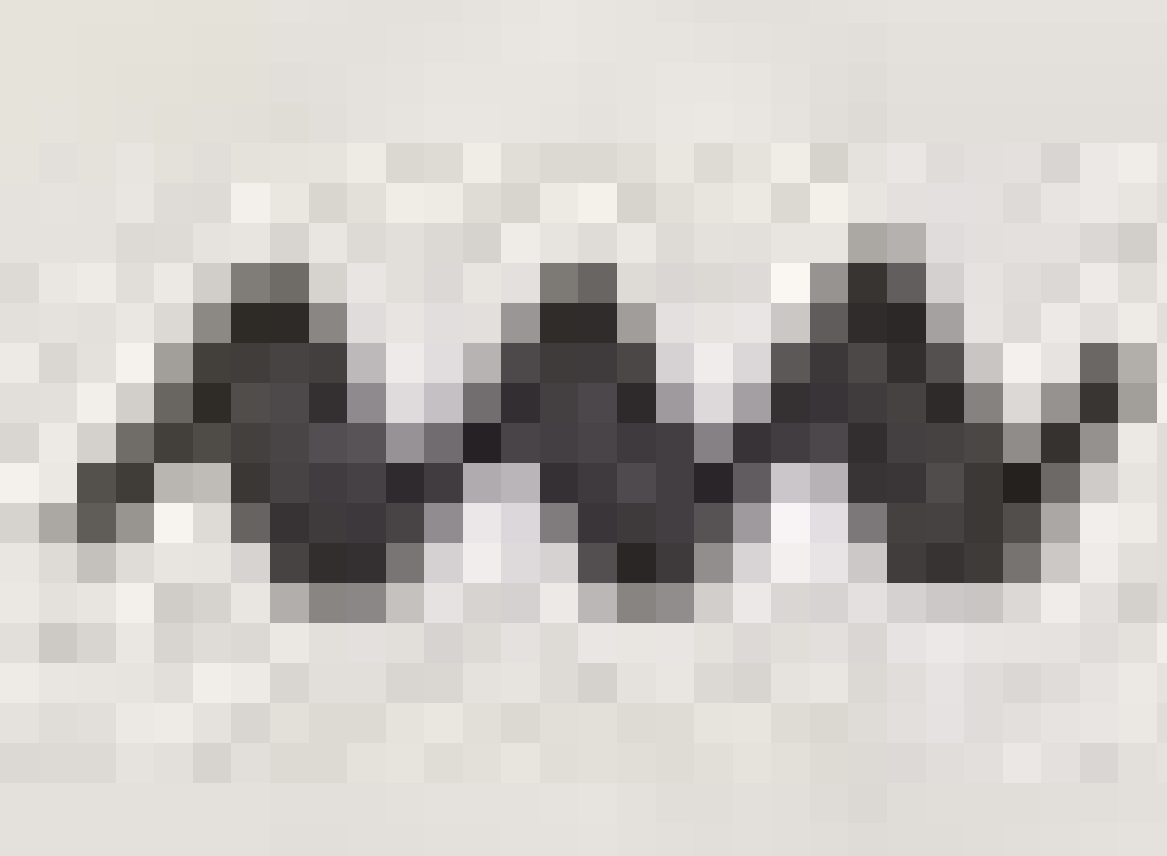 for the alto in m. 46. A Schleifer will not upset this indication; it is fitting with the configuration here. A trill in m. 64 is shown in Am. B. 548, P535, P577, where a long trill is placed in the second beat in the bass. This placement of the trill is fitting in the long valued bass note; it also suits m. 46, the parallel measure with m. 64.
for the alto in m. 46. A Schleifer will not upset this indication; it is fitting with the configuration here. A trill in m. 64 is shown in Am. B. 548, P535, P577, where a long trill is placed in the second beat in the bass. This placement of the trill is fitting in the long valued bass note; it also suits m. 46, the parallel measure with m. 64.
I recommend the trill in the bass in these measures. Following Am. B. 548, beginning the trill on the second beat allows the diminished chord on the first beat to establish itself upon the ear with no distraction and at the same time preserves the rhythmic momentum of the downbeats. A Nachschlag elegantly rounds off a long trill; the performer may choose to include or omit a Nachschlag here. Either way is valid.
Suggested treatment for mm. 46 and 64:

- M. 71. In P651, no embellishment is indicated in either part, but both its branches P289 and P887 include a long trill symbol and a t in the upper and lower parts, respectively.
- M. 80. I favor a Nachschlag at the end of the trill in the soprano part.
IV.B.1.b. Long Trills
Beginning the trills in the Fugue on the upper auxiliary is recommended due to harmonic and contrapuntal factors. The less obvious matter for consideration is when to commence the trills. A trill on a long note is not an isolated phenomenon; rather, it is interactive with its harmonic, contrapuntal and rhythmic surroundings. The decision as to when to begin a trill depends, in each case, on the structural situation. A trill does not always begin on the initial beat. The main note may be held and the beginning of the trill must coincide structurally with the contrapuntal movements of the other parts and the harmonic progression of the moment. The following treatments illustrate 1) beginning immediately on the beat, and 2) holding the main note before trilling.
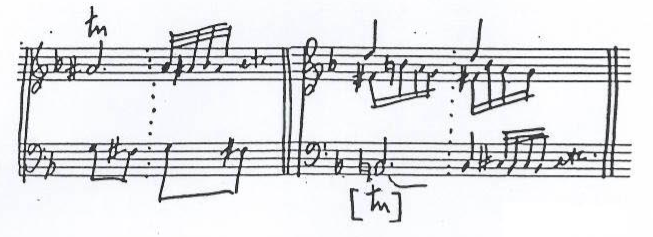
- Mm. 53-54. P212 demonstrates that a long trill, extending throughout at least these two measures, was expected here in the soprano part. P887 and P289, the derivative manuscripts of P651, both indicate a trill at m. 54 only. Mm 101-102 parallel mm. 53-54 and may be treated similarly with a long trill.
- Mm. 91-93, 107-110, 132-134, 155-157. The long organ points in the bass begin to accumulate; introduced at mm. 91-93, they appear henceforth at strategic harmonic arrival points mm. 107-110, 132-143, 155-157 as the fugue builds to the end. These organ points contribute powerful support to the unfolding of the harmonic scheme and the traversal of the subject combined with its counterpoint. No amount of skill on the part of the harpsichordist or pianist can sustain or create the illusion of a sustained tone for the duration of several measures on either instrument. This is an attribute of the organ. The piano´s sustaining pedal will be of no help for it would blur the linear contrapuntal and harmonic progress. However, in the situation here, one can have recourse to the trill that retains the full value of these organ points. The historical practice of adding a trill on a long-valued note is so well established that it requires no documentation here. For these reasons, I favor a long trill on all the organ points in these measures. In view of the harmonic and contrapuntal circumstances in each case from m. 91to m. 157, no Nachschlag needs be added. However, a Nachschlag is suitable at the end of the trills indicated at mm. 80 and 91. The taste and technical facility of the individual performer may determine the speed of trills.
IV.B.2. Dynamics on the Piano
In performance on the piano, the very nature of contrapuntal structures forms the primary factor in the treatment of dynamics. Therefore, the parts should be continually differentiated in dynamic levels in order that the structural levels of the contrapuntal lines be observed.
IV.B.3. Phrasing and Articulation
Both inner and long phrasing should be taken into consideration. The inner phrase is to be shaped as an inner breath in relation to its neighboring phrase rather than ending in a distinct break; a tonal accent on the first note of each inner phrase must be avoided.
IV.B.4. The Fugue Concept
The Fugue follows the historical convention of contrast with its partner movement, the Fantasia. The chromatic fugue subject and the figure, which plays a principal role in the countersubject and episodic material, are employed similarly in the Fugue in F minor BWV 857, from Book I of the Well-Tempered Clavier. Bach´s use of chromaticism is repeatedly directed to works of introspective character. The short figure that serves as a foil in short-valued notes to the long subject and its long-valued notes has influenced performers to play the Fugue in a brisk, motoric manner. Due to the chromatic and structural style of this fugue and its profoundly introspective character, as in the above-mentioned Fugue in F minor, I lean to an andante tempo rather than a brisk one and an introspective conception that contrasts greatly with the more extroverted character of the Fantasia.
N. of ed.: Further information regarding tempo and dynamics in the Griepenkerl edition: “This edition is a jump to Emil von Sauer, whose edition has been used a great deal. You see immediately the use of crescendo-diminuendo throughout. Again there is no attempt at matching this with any manuscripts or early editions. (…) Now he has a tempo mark there: a quarter note, tempo mark Allegro moderato⎯Moderato we find in almost every edition as an opening tempo instruction because it is a very safe one, isn´t it? Mezzo-forte is also a very safe dynamic indication, also mezzo-piano. But anything beyond either one of them and you are on very dangerous ground. So anything that is mezzo or moderato is fairly safe and therefore I suggest that you don´t pay much attention to it (…) It´s too safe for Bach´s style. Now that is quite fast tempo and this is what I call, with all due respect, a pianist´s tempo, and it is a tradition that has been perpetuated (…) In such a tempo, that becomes very pianistic. Now that is not to say that this work, this Chromatic Fantasia and Fugue, is not very effective on the piano. But this is making a piano piece out of it. Sauer is certainly one of the very important influences in making this kind of interpretation a tradition. This tempo and this short of short, quick play.” (‘Manuscripts and Editions’: 14-15)
Regarding the ending of the Fugue: “You see again how he has treated the end with octaves, the subject in octaves and the end in lower octaves. In other words, it is a gradual enlargement of the framework of the Fugue for the sake of bigness and majesty and climax. Now what is the trouble with octaves in Bach? (…) You see, the transcribers were very great musicians; they were some of the very great performers and composers and they were very sincere in their quest for the true Bach style, just as we are sincere in our quest for the true Bach style. They became aware of the organ and the harpsichord and realized that on these two instruments you can double; you can have octaves above with the four-foot and octaves below with sixteen-foot, etc. (…) So octaves were added and they were absolutely justified because this was a direct stylistic device taken right out of Bach´s time and Bach´s instruments. Octaves were absolutely correct. They were unfortunately in great error because with the knowledge to act in the literal way in art you are sure to be wrong; just as it is dangerous to be safe (…) Because they were absolutely correct in using octaves as a direct device on the harpsichord and the organ; they were absolutely wrong because these are octaves, these are not doubling of line. It is virtually impossible to play any of these doublings on a piano as line so that the entire idiom is changed. They are played as virtuoso octaves. Therefore the transcriptions have no meaning, they have no pertinence, they have no relation to Bach´s music.” (‘Manuscripts and Editions’: 16-17)
NOTES:
[1] Dr. Tureck, in some of the initial drafts of her edition, calls the 1969/70 Henle publication (von Dadelsen, and Rönnau) and the 1962 Peters edition (Keller), “stepping stones in source materials for Interpretive Editions”. Today, the most complete critical commentary of BWV 903 is to be found in the New Bach Edition. See Uwe Wolf, ed. Johann Sebastian Bach, Neue Ausgabe sämtlicher Werke. Series V: Klavier- und Lautenwerke, Volume 9.2: Sechs kleine Praeludien/Einzeln überlieferte Klavierwerke I. Kritischer Bericht. Johann-Sebastian-Bach Institut Göttingen and Bach Archiv Leipzig. Kassel: Bärenreiter-Verlag, 1999.
[2] The History of Bach Performance was still a work in progress during the last years of Dr. Tureck´s life, but its structure and content were already in a developed stage by the time of her death, in July 2003. As explained in the Introduction to these essays, the unfinished book elaborates in great detail on the history of editions of the Chromatic Fantasia and Fugue, depicting a “historical promenade” that departs with the Griepenkerl edition of 1819 and subsequently analyzes more than sixty editions up to approximately 1970. See also the chapter dedicated to Griepenkerl 1819, the first performance edition of the Chromatic Fantasia and Fugue.
[3] This issue raises many further questions in regard to what is actually a musical work and what it is that we perform. The debate around these questions is dealt with widely in Michael Talbot, ed. The Musical Work. Reality or Invention? Liverpool University Press: 2000.
[4] See the essay on the Rust Variant for a detailed account of Dr. Tureck´s view of the early version BWV 903a.
[5] See the essay on the Griepenkerl edition for a detailed account of Dr. Tureck´s view thereof.
[6] Paul Badura-Skoda: Daß in P 212 sowohl die Fantasie sowie auch die Fuge mit einem d-Moll-Akkord enden, dürfte wohl kaum Bachs Absicht entsprochen haben. Trotzdem könnte auch diese Fassung in mancher Hinsicht authentisch sein. “The fact that, in P 212, both the Fantasia and the Fugue end with a D-minor chord would hardly befit Bach´s intentions. However, this version could be authentic in some regard.” (Badura-Skoda, ‘Einige Text- und Interpretationsprobleme in der Chromatische Fantasie und Fuge, BWV 903.’ App. III in Bach-Interpretation: 485).
[7] I am most grateful to Prof. Christoph Wolff for providing me with this valuable information and to Dr. Peter Wollny and Kristina Funk-Kunath, at the Bach-Archiv Leipzig, for their assistance with the manuscript.
[8] Dr. Tureck´s attitude toward instruments and to authenticity, outlined in the Introduction, should also be considered here: “There was a period when I liked this work best on the clavichord. I preferred it on the clavichord to the harpsichord or piano. And I feel that size has nothing to do with bigness; size⎯quantity of tone⎯has nothing to do with the quality of bigness or majesty or large framework. And this must be a fact because instruments of this kind were made and considered very satisfactory for centuries for all kinds of music.” (‘Manuscripts and Editions’: 19).
[9] N. of ed.: See the Introduction to the articles for a more specific account of the conception of the book.
[10] N. of ed.: Uwe Wolf, editor of the Urtext of the Neue Ausgabe Sämtlicher Werke (1999), indicates that the work ″has survived in no fewer than thirty-eight manuscripts, some thirty of which probably date from the eighteenth century, We also know from inventories of personal libraries and posthumous estates that at least eighteen manuscript sources existed at one time that are no longer extant today″ (Wolf, Preface, Chromatic Fantasy, IV).
[11] M. 6796. Bibliothèque de l´Arsenal, Paris (Cyr, Bach´s Music: 256-59).
[12] N. of ed.: The name of this library has been altered several times due to the political partition of the city of Berlin that geographically divided it until the fall of the U.S.R. in 1989. The Staatsbibliothek Preußischer Kulturbesitz, where Dr. Tureck consulted these manuscripts, was West Berlin´s State Library between 1968 and 1991. Deutsche Staatsbibliothek was the name of the East Berlin library between 1954 and 1990. Between 1990 and 1991, it became Deutsche Staatsbibliothek in der Stiftung Preußischer Kulturbesitz. From January 1992, both libraries are unified under the name Staatsbibliothek zu Berlin - Preußischer Kulturbesitz, Musikabteilung mit Mendelssohnarchiv. All manuscripts from the two former libraries listed above are now housed in the latter, the Staatsbibliothek zu Berlin - Preußischer Kulturbesitz, Musikabteilung mit Mendelssohnarchiv (http://staatsbibliothek-berlin.de/die-staatsbibliothek/geschichte, accessed May 29, 2012). Manuscripts from this library are now usually identified as belonging to the Staatsbibliothek zu Berlin, Preußischer Kulturbesitz.
[13] N. of ed.: as are the more recent Wiener Urtext Edition and the Urtext of the Neue Ausgabe sämtlicher Werke (Bärenreiter).
[14] N. of ed.: the other one, Mus. Ms. Bach P803 (2), being in the hand of Samuel Gottlieb Heder. See Stauffer, Enigma, Table 1: 167.
[15] according to Hermann Zietz (Zietz, Untersuchungen).
[16] N. of ed.: see the chapter on the Rust Variant for comprehensive information about this manuscript.
[17] N. of ed.: ‘Einige Bemerkungen über den Vortrag für Chromatischer Phantasie von F. Griepenkerl’, appendix to the Peters 1819 edition.
[18] Kollmann, A.F.C. Johann Sebastian Bach´s Celebrated Fantasia Chromatica for the Piano Forte with some Additions by A.F.C. Kollmann (London, Preston: 1806).
[19] This question of clef usage in the Bach sources has been dealt with extensively by Russell Stinson in Stinson, Chronology: 440-470.
[20] N. of ed.: It might be useful to bear in mind here the following “rules” and general guidance provided by Dr. Tureck in her study The Performance of Bach (a 2003 revision of her three-volume essay Introduction to the Performance of Bach, Oxford University Press, 1960):
Ornamentation is indispensable.
It is as much part of the musical structure as the printed notes.
It is a shorthand notation of musical figures.
It influences not only melodic line, but also all the other elements of music⎯rhythm, harmony, and structure, and all the elements of performance⎯phrasing, tempo, touch, dynamics, and these in turn influence it.
It is a written system which is comprehensible only to the literate; it has its own terms, its own idiomatic expressions, its own nuances of meaning and expression, all of which are expressed by an communicated through symbols.
Ornamentation forms a mass of rules and categories of types which allow exceptions, variations, improvisation, and personal freedom. Therefore, scholarship, judgment and feeling must all be present in its practice.
The fundamental thing to learn is that the basic rhythm of eighteenth-century ornamentation is built on the beat. Ornaments always are and must be conceived as an intrinsic part of the figure, whether the figure is a melodic line, a short rhythmic motive, or whatever. In order to perform the ornaments not only correctly but also in their characteristic style, give them enough time to be playable and comprehensible. Virtually all ornaments begin on the note above the main note except where otherwise indicated in the symbol itself. The auxiliary note is usually a whole tone above the main note. This differs again from nineteenth-century practice where graces and trills are almost always taken with the semitone. (Tureck, Performance, 21, 22, 23)
[21] ‘Einige Bemerkungen über den Vortrag für Chromatischer Phantasie’, in J.S. Bach Chromatic Fantasia and Fugue, edited by F.D. Griepenkerl, Leipzig, C. F. Peters, 1819.
[22] “Russell, in his book, printed in 1812, shows that the attachment for the old Echo still lingered exactly a century after it had been improved upon by the invention of the Swell (1712), by directing at the head of one of his pieces, `The Swell Pedal not to be used in this movement´.” Edward John Hopkins, Grove, Vol. I: 728.
[23] N. of ed.: Praetorius/Crookes, Syntagma, II:53.
[24] 12 N. of ed.: Paul Badura-Skoda expresses a similar view in his illuminating commentary on the interpretation of the arpeggio section:
Wäre Bach wirklich daran gelegen gewesen, diese Arpeggien motivisch auszuarbeiten, auszukomponieren, dann hätte er, dem das Pädagogische so sehr am Herzen lag, doch wohl wenigstens einem seiner Schüler gezeigt, wie so eine Ausgestaltung aussehen müßte. Nun enthält aber keine einzige der Abschriften aus seinem engsten Schülerkreis⎯mindestens fünf sind nachweisbar⎯auch nur den geringsten Hinweis für eine motivische Ausgestaltung der Arpeggien. (Sie sind abgesehen von T. 27 nur als Akkorde notiert.)(…) Doch wie kann und soll man diese Arpeggienstelle ausführen? Zunächst ist es empfehlenswert, sich die formale Funtkion der Arpeggiostelle innerhalb der Fantasie klarzumachen. Wie leicht ersichtlich, bilden die arpeggierten Akkorde den Mittelteil der Fantasie, eingerahmt von dem virtuos zu spielenden Toccatateil und dem Instrumentalrezitativ (welches seinerseits durch toccatenartige Läufe unterbrochen wird), die die Form abrunden.
“Had Bach been really so interested in motivically working and writing out these arpeggios, he, being such a devote pedagogue, would have at least showed one of his students how to flesh them out. However, none of the copies from his closest circle of students (at least five are identifiable as such) include any indication whatsoever of their configuration⎯they are written just as chords with the exception of m. 27. So how is this arpeggio passage to be performed? In the first place, it is recommendable to come to grips with formal function of the passage within the Fantasia. As can be easily seen, the arpeggiated chords configurate the middle section of the Fantasia, framed by the virtuosic toccata-like section and the instrumental recitative (interrupted also by toccata-like runs), which round up the form” Badura-Skoda, ‘Zur Ausführung der Arpeggien in der Chromatischen Fantasie und Fugue’, in Bach-Interpretation: 412-13.
[25] N. of ed.: the different versions recorded by Dr. Tureck that have been mentioned in the editor´s preface are a perfect example of this.